Trying to plan the perfect Oregon coast road trip? We’re here to help make the process less stressful. The Oregon coast is a phenomenally beautiful road trip, so you’re sure to be in for the time of your life.
The coast is made of charming coastal towns, impressive sea stacks, constantly shifting sand dunes, natural rock bridges, secluded beaches, crashing waves, and historic lighthouses. You’ll be met with impressive ocean views and refreshing salty air. We’ve explored the Oregon coast extensively and hope you’ll fall in love with its natural beauty like we did.
This is truly one of the Best Road Trips In The USA so you are in for a real treat!
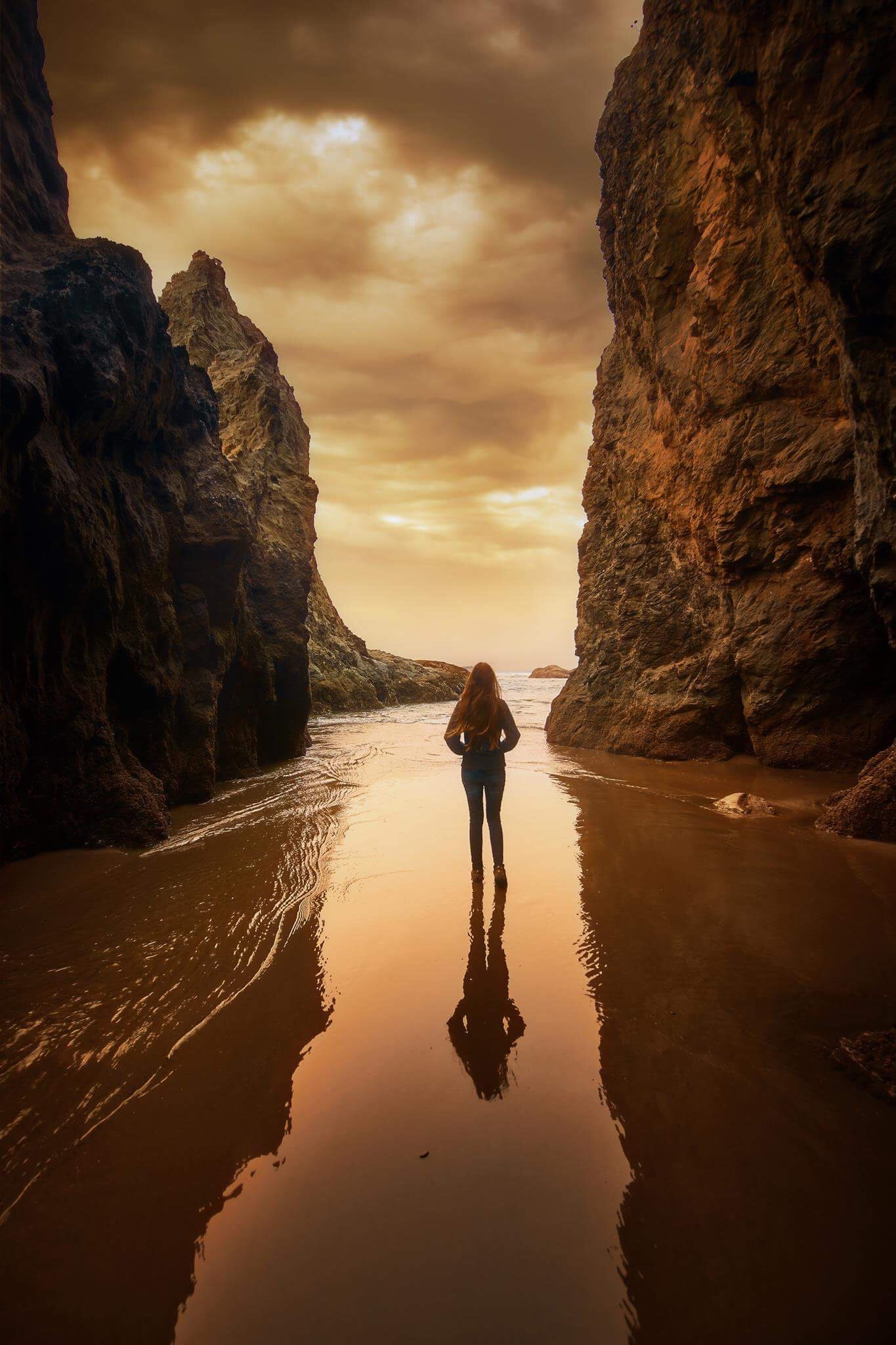
The Ultimate Oregon Coast Road Trip Itinerary You Should Steal
Getting To The Oregon Coast
You have a number of different options when deciding how to begin your Oregon coast road trip. First you’ll need to decide which of the 11 stops you plan to visit on your trip. Often, flying into Portland, Oregon makes the most sense.
It’s a large city and you’re sure to find affordable flights that will get you there. From here you can make the long drive to the Samuel H Boardman State Scenic Corridor, and make your way up the coast.
Or perhaps you only have time to complete half the road trip in which case you might want to look into flying into Eugene, which roughly splits the Oregon coast itinerary in half. It will often be a more expensive choice than flying into Portland, but it is the logical choice if you’re only completing the upper or lower half of the itinerary. A couple of other options include flying to San Francisco and driving up the rest of the California coast to begin your Oregon coast road trip, or flying into Seattle and driving down the coast.
Don’t forget to check out our Detailed Road Trip Packing List so you don’t forget any essentials for your trip!
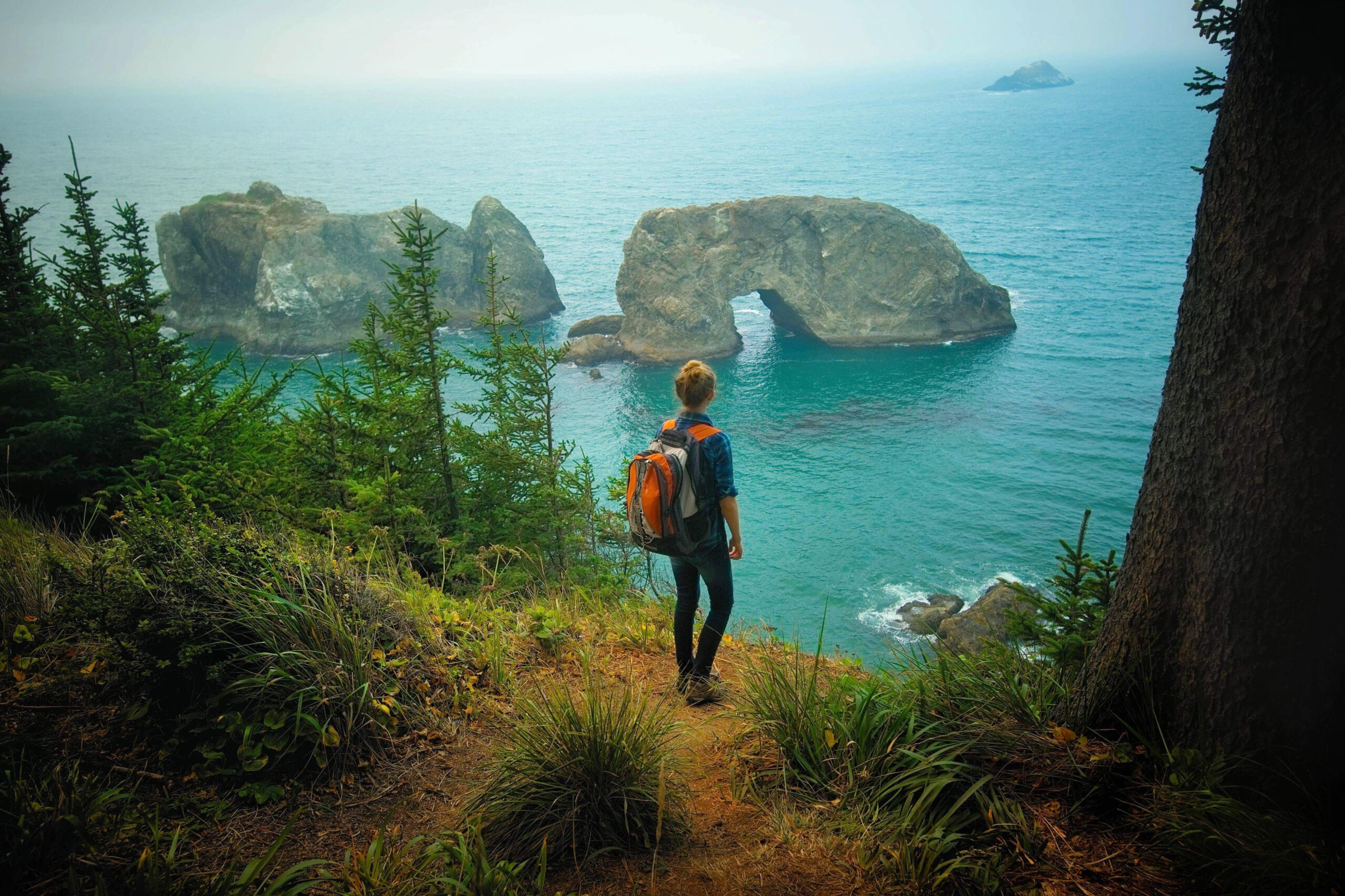
Each of these cities that we’re suggesting you fly into are also worthy stops themselves should you choose to spend a bit of time there before starting your Oregon coast drive. San Francisco is the land of golden gates, cable cars, great food, irresistible chocolate, hikes, beaches, and plenty of history and excitement. The popular urban city of Seattle has fresh food, beautiful waters and creative architecture.
Portland is a colorful, eccentric, environmentally conscious city with food trucks, addicting donuts and impressive bookstores. And as a university town, Eugene has the benefits of the University of Oregon being at the heart of its city as well as the beauty of nature right in its backyard.
Don’t forget to check out some of the Best Airbnbs In Oregon, from cute cabins to treehouses and more!
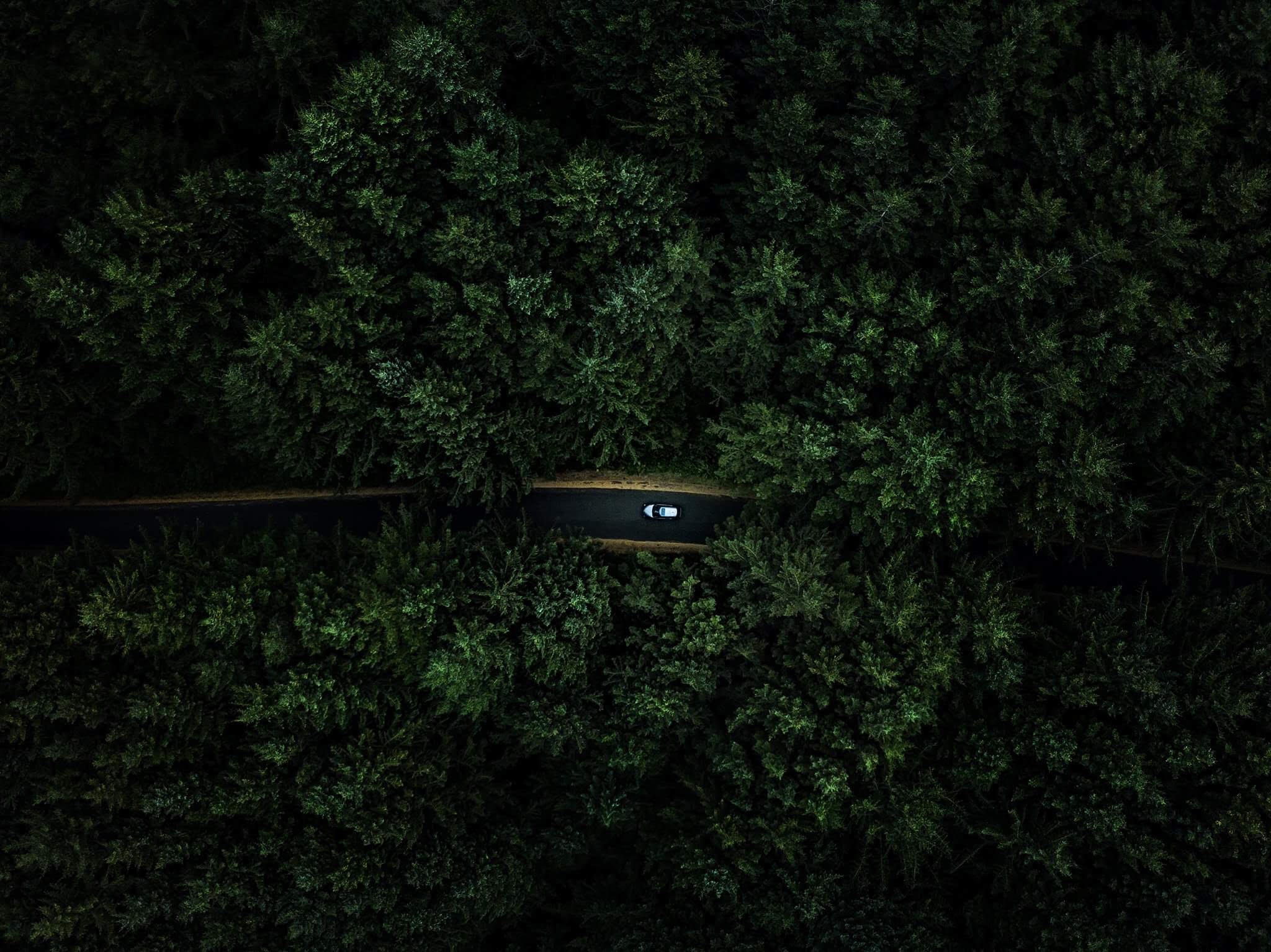
Getting Around The Oregon Coast
We hope that if you’ve found yourself reading our itinerary you love road trips, because driving the Oregon coast is the only way to get to all the stops we’re suggesting. Oregon is a big state, and though you may be starting your trip in a bigger city, this Oregon coast road trip itinerary has remote stops that are best reached by car. You should also be aware that there are no self-service gas stations in Oregon, so don’t be alarmed when an attendant comes over to fill your tank.
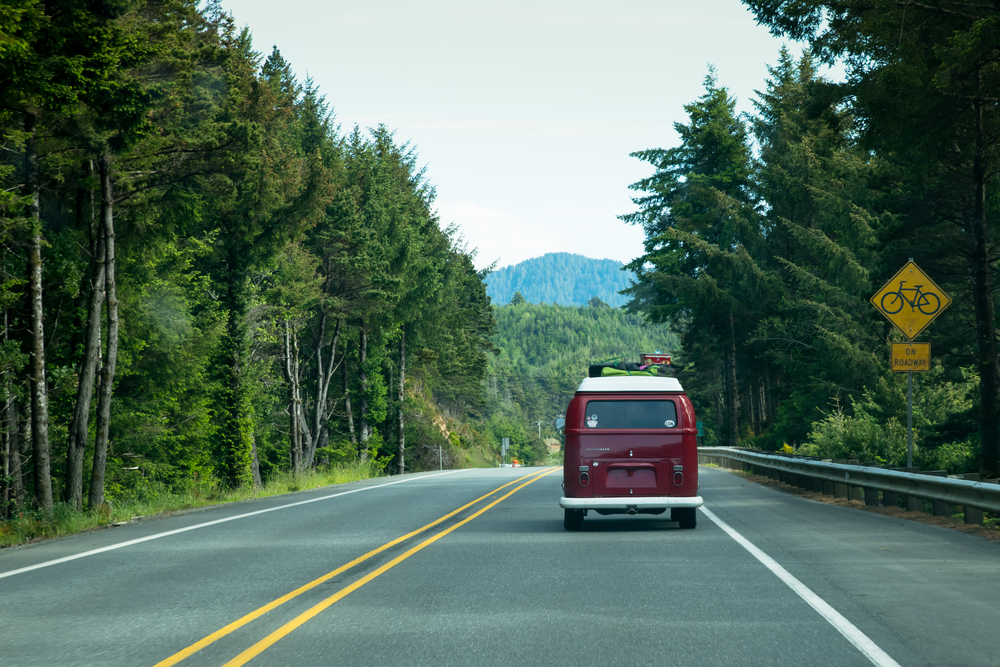
Planning Your Oregon Coast Road Trip Itinerary
As we mentioned, there are a number of different ways to tackle this Oregon coast road trip itinerary. Assuming you are flying into Portland, you can choose whether to start the road trip from top to bottom or bottom to top. Our favorite route is making the long drive from Portland to the Samuel H Boardman State Scenic Corridor and making our way up the coast from there.
If you’re short on time and don’t have the ability to include all 11 stops on your road trip, you can also choose to only do the bottom half of the itinerary from Brookings to Florence or do the top half from Florence to Astoria. Which route you choose is entirely dependent on your own time constraints and personal preferences.
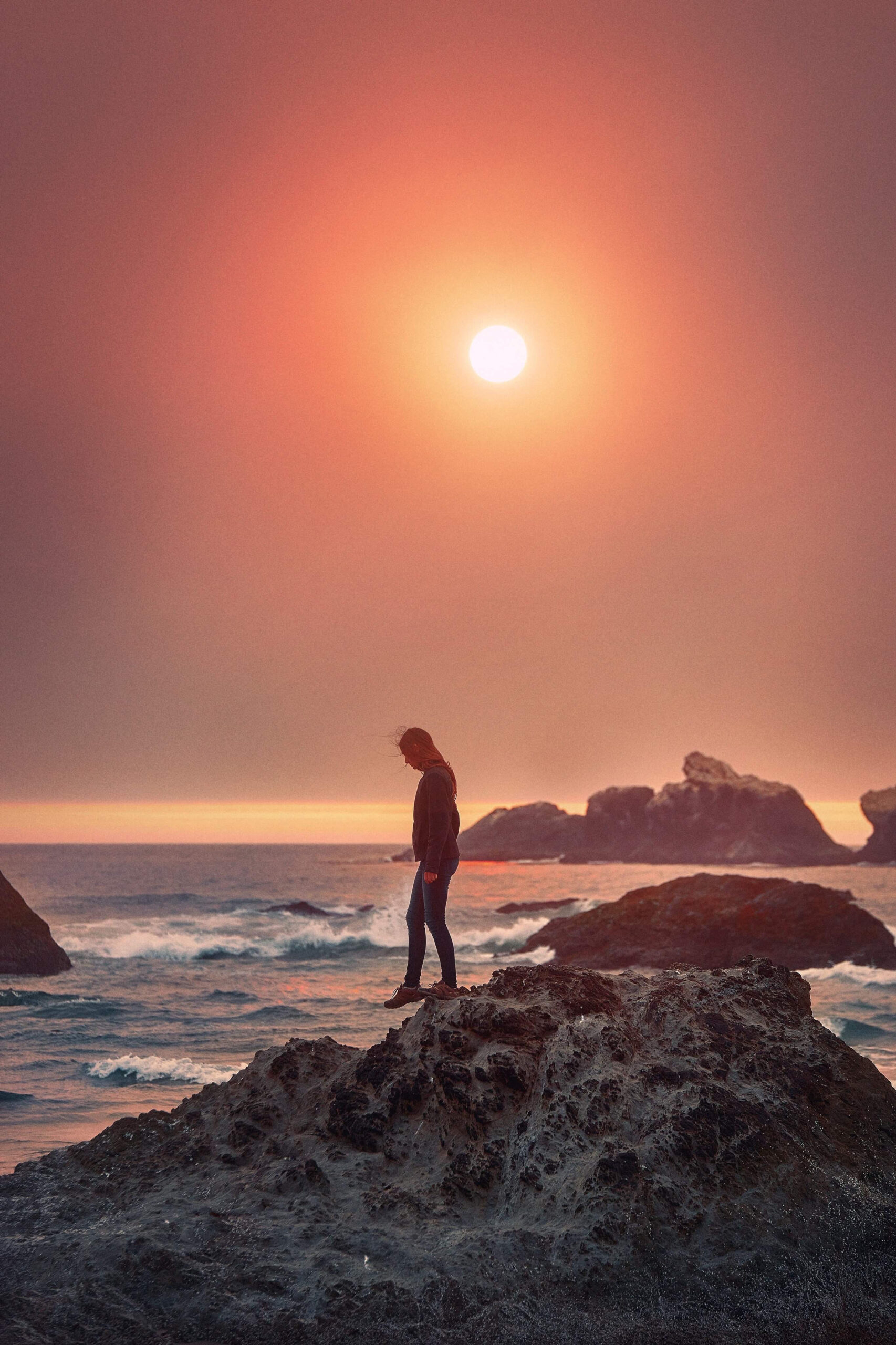
Stop 1: Begin Your Oregon Coast Road Trip By Hiking Throughout The Samuel H Boardman State Scenic Corridor
You’ll soon find that the Oregon coast is dripping with stunning scenery and the 12 mile stretch of coast that makes up the Samuel H Boardman State Scenic Corridor (named after the first Oregon Parks superintendent) is no exception. Exploring this spectacular stretch of coastline is best done by hiking any number of its fantastic trails.
There is a great collection of easy-moderate trails in the area that will take you to breathtaking viewpoints and natural beauties. In addition, 27 miles of the Oregon Coast Trail are located within the corridor.
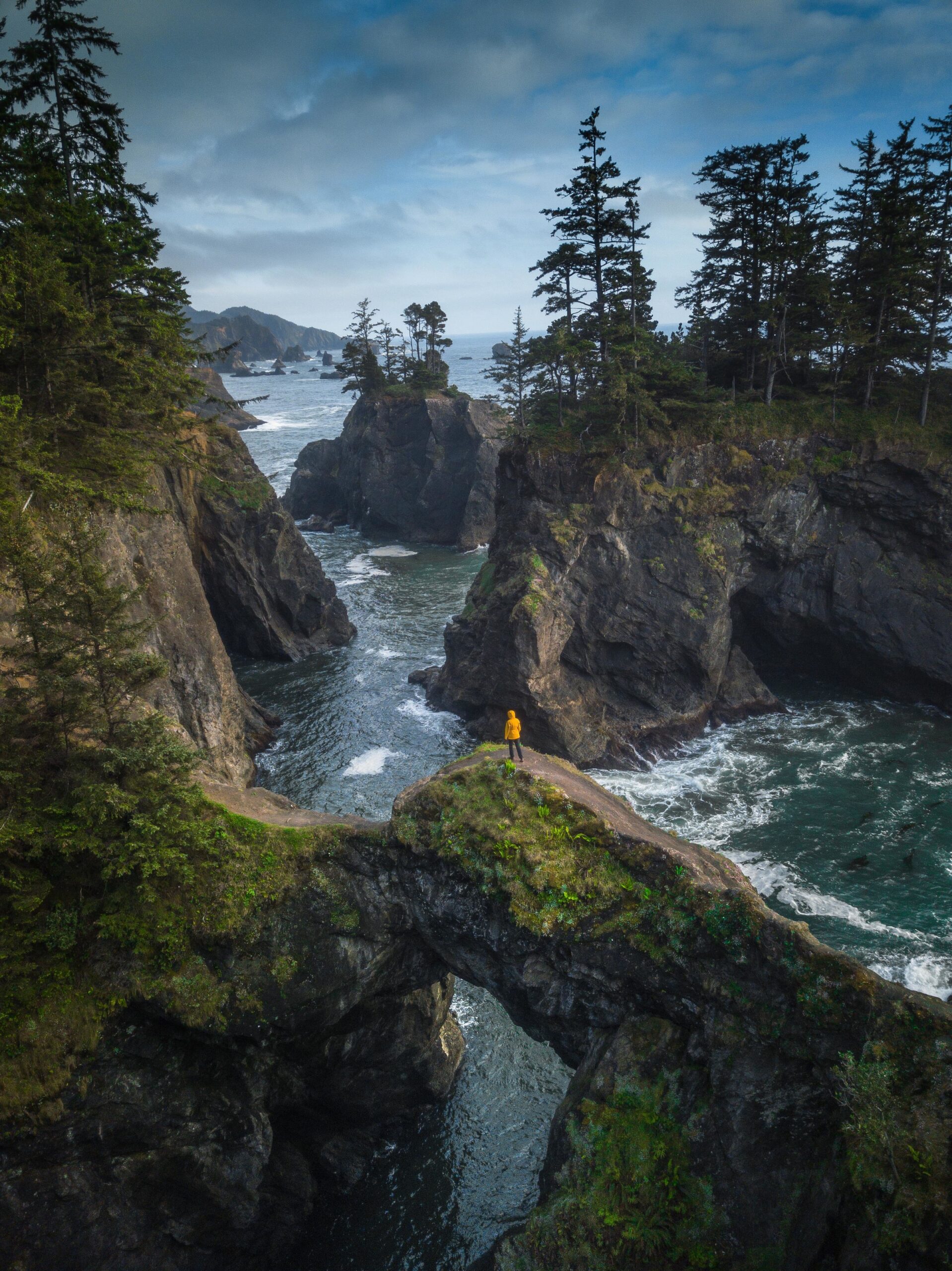
Best Hikes In The Samuel H Boardman State Scenic Corridor
Arch Rock Point & Spruce Island Viewpoints Trail (Mile 344.8)
This is an easy .2-mile loop trail taking you to the cliff’s edge to two wonderful viewpoints where you can gaze out at the vast, brilliant ocean. A number of picnic tables are available for you to hang out for a bit and enjoy the surroundings.
This is the perfect hike for all ages and ability levels because it requires very little energy for a huge payoff. If you like crashing waves, towering rocks and brilliant blues, you’ll enjoy this hike.
Secret Beach (Between Mile Marker 344-345)
Secret Beach is appropriately named because it is secluded, sheltered and not heavily trafficked. This hike will take you to beautiful waterfalls, tide pools and a beach that is a haven for peace and quiet.
The best and safest time to visit the beach is at low tide. There are a couple of different trails you can take. The longer one begins at the turnout for the Thunder Rock Cove parking area.
You’ll find Secret Beach to the left of Thunder Cove Beach. Make sure you wear proper footwear, as you’ll be climbing over boulders at the bottom to reach the beach. The other option is a much shorter but steeper trail that follows Miller Creek.
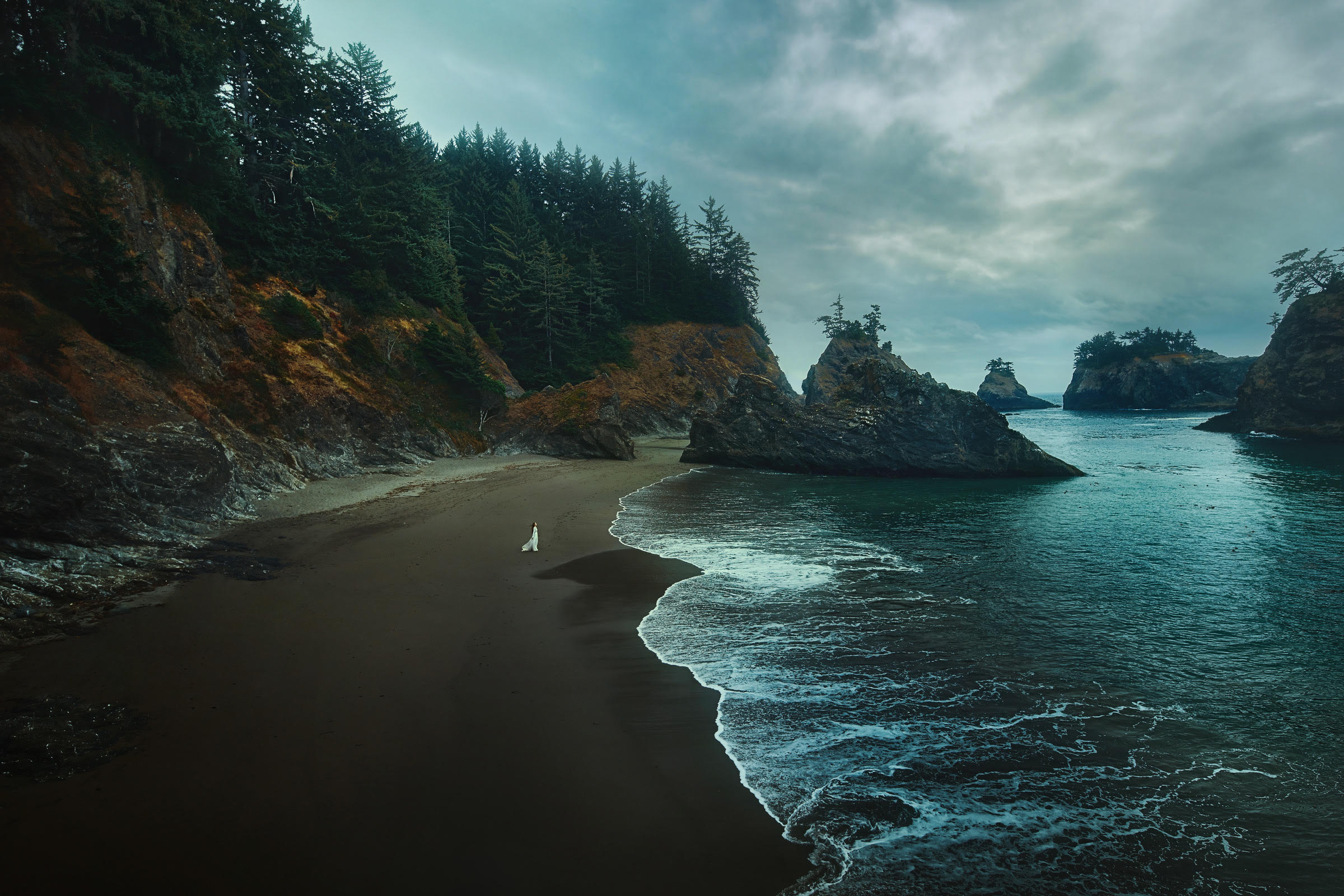
North Island Viewpoint (China Beach) Trail (Mile 347.4)
Though there are a number of ways to access China Beach, the best way to get down to the beach is to take the North Island Viewpoint Trail. Reaching the viewpoint is only .5 miles and will take you to a spectacular viewpoint with views of the Natural Bridges.
If you choose to continue down to the beach, you’ll be hiking for a total of 1.2 miles round trip. The pristine beach and sea stacks jutting out of the water are worth the extra hiking. This beach is part of the greater Oregon Coast Trail.
Indian Sands (Mile 348.6)
The Samuel H. Boardman State Scenic Corridor has a little bit of everything. We’ve taken you through trails that lead to spectacular viewpoints, secluded beaches, and naturally stunning rocks. On top of all that, you can also find sand dunes within the corridor.
These cliff top sand dunes are incredibly unique and collect their sand from the sandstone cliffs rather than the ocean. In the springtime you’ll also see a lot of beautiful wildflowers. Imagine relaxing with your shoes off and your toes in the sand, surrounded by wildflowers and great views of the ocean.
It’s all incredibly picturesque. There are a number of trail possibilities, but you’ll want to take the southern trail. No matter which way you get there, it’s a fairly steep, somewhat challenging hike despite only being a mile long.
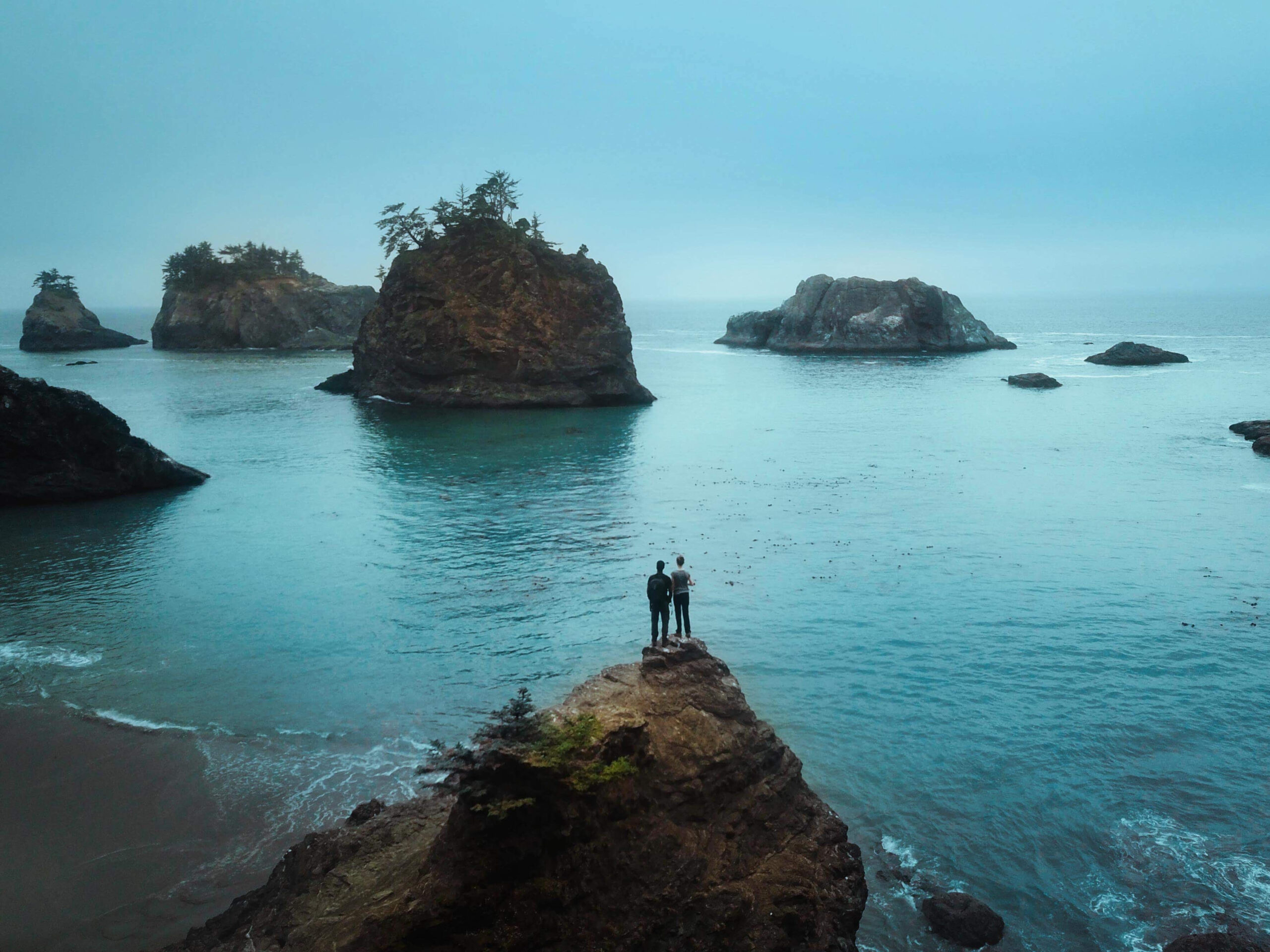
Additional Recommended Samuel H. Boardman State Scenic Corridor Stops:
- Spruce Island (Mile 345.0)
- Thunder Rock Cove (Mile 345.8)
- Natural Bridges (Mile 346.0)
- Thomas Creek Bridge (Mile 347.8)
- Whaleshead Overlook (Mile 349.3)
- House Rock (Mile 351.2)
- Cape Ferrelo (Mile 351.9)
- Lone Ranch Picnic Area (Mile 352.6)
Where to stay near the Samuel H Boardman State Scenic Corridor:
Mid-range: Beachfront Inn. Check rates: Booking.com
Budget: Pacific Reef Hotel & Light Show. Check rates: Booking.com
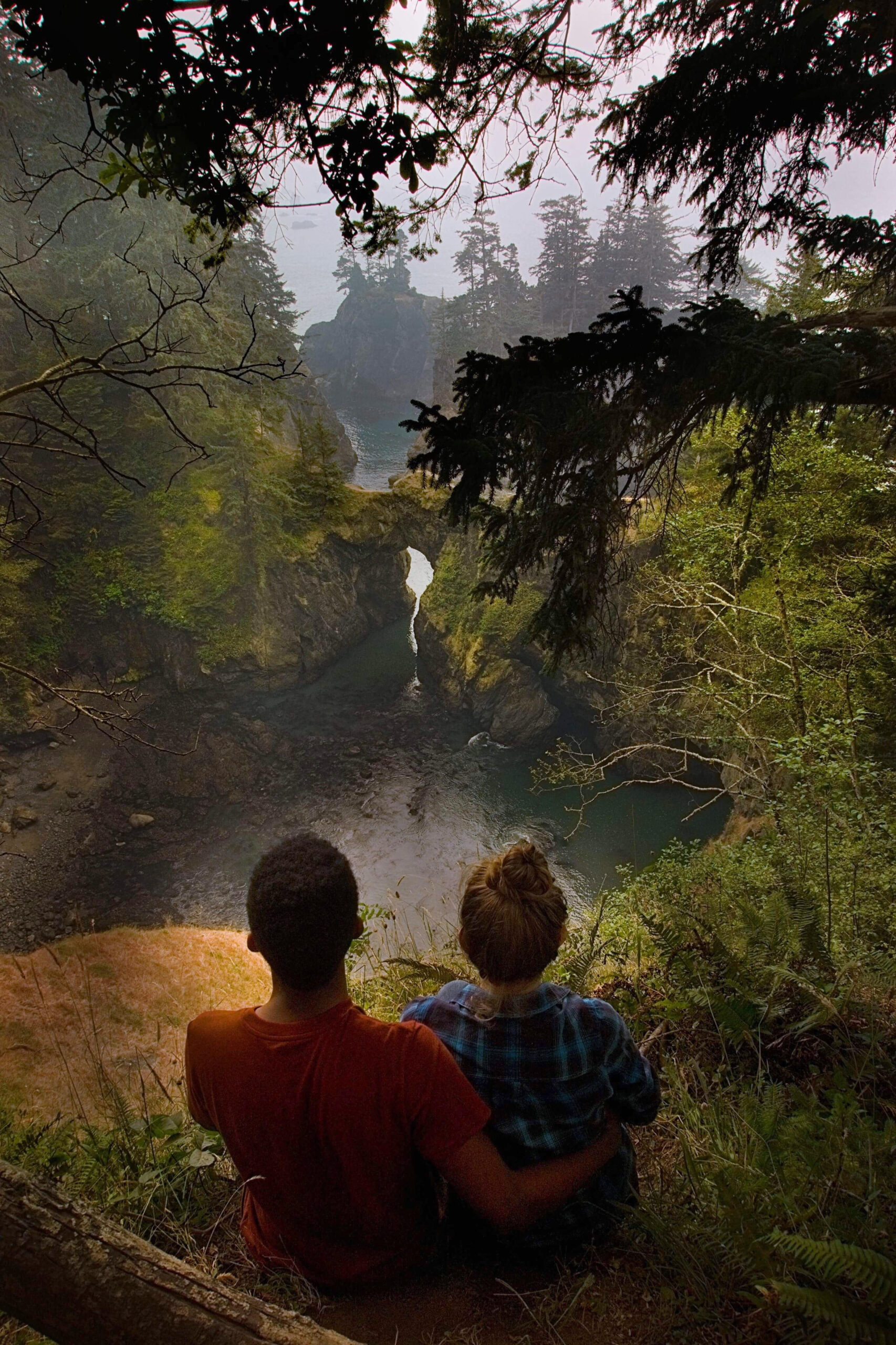
Stop 2: Continue Your Oregon Coast Road Trip At Port Orford And Cape Blanco State Park
You’ll love spending time in the tranquil town of Port Orford, the oldest town along the Oregon coast. It also happens to be the westernmost city in the contiguous United States.
This town embraces the small-town feel and boasts a thriving arts scene while also giving you plenty to do in the way of water activities, fishing and general outdoor exploration. Sometimes wandering the area and taking in the unexpected, stunning views you might find is the ultimate way to explore.
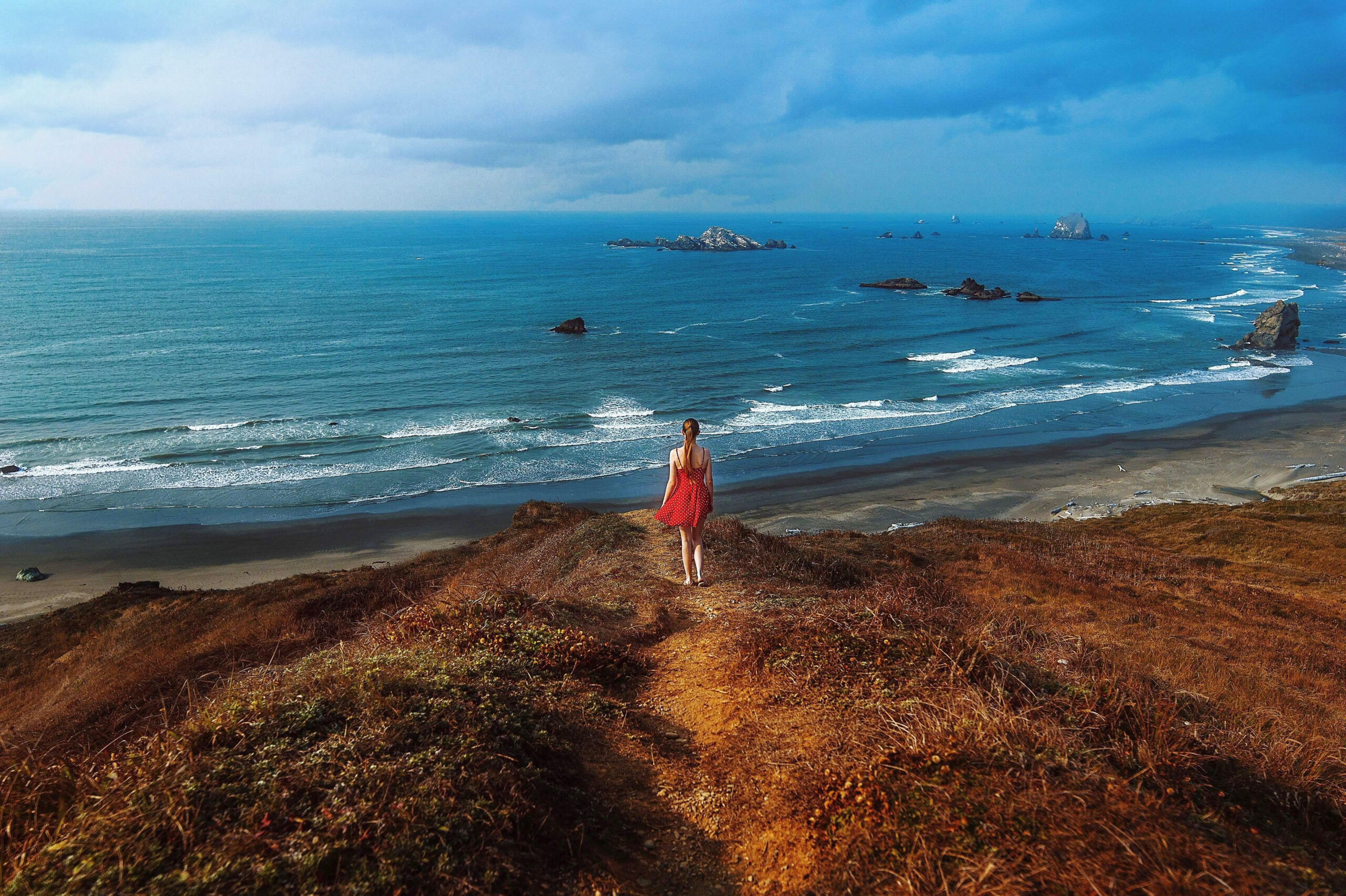
For beautiful views mixed with a slice of history, head to Battle Rock Park known for the 1851 historic battle between the Qua-to-mah Native Americans and Captain William Tichenor’s men. With picturesque beaches, free parking and restrooms, this is the perfect place to stop and enjoy the scenery. There’s a visitor’s center as well as informative signs if you’re interested in learning more about the area.
Nearby is Cape Blanco State Park, the westernmost point in Oregon and a spot you’ll definitely want to stop and explore. In addition to hiking trails and exceptional views, you’ll want to visit The Cape Blanco Lighthouse, Oregon’s oldest continually working lighthouse.
From April to the end of October, you can tour the lighthouse for $2 (closed on Tuesdays). Besides the information you’ll pick up on the tour from the knowledgeable volunteers, the view from the lighthouse tower is incredible.
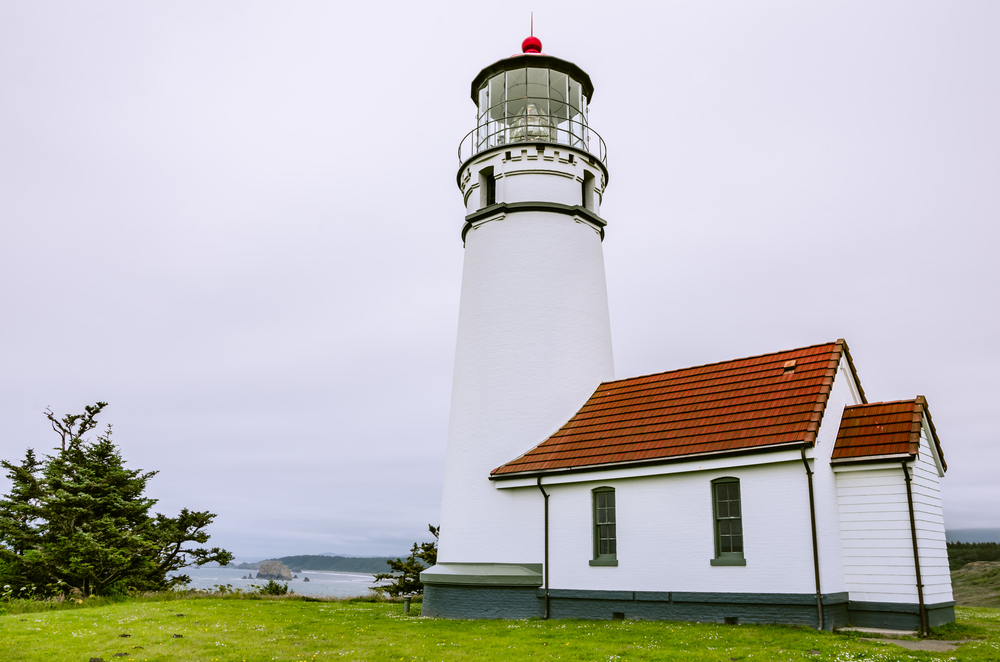
For another look at a historic landmark, you might be interested in viewing the Hughes House, a 3,000 square foot Victorian farmhouse built in 1898 for Patrick and Jane Hughes. This home and the lighthouse are both listed on the National Register of Historical Places.
You can tour the home from May-September (closed on Tuesdays) and hear about the story of the house from volunteers. The home is restored and in good condition and is fun to experience as a little piece of Oregon history.
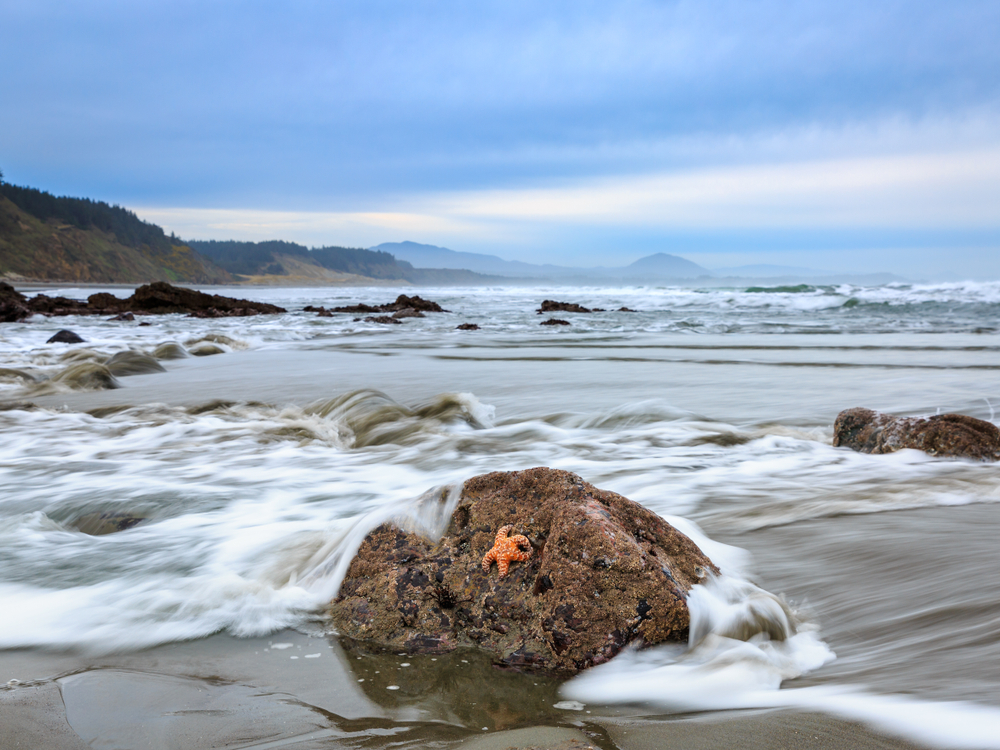
Where to stay near Port Orford and Cape Blanco State Park:
Mid-range: Castaway by the Sea. Check rates: castawaybythesea.com
Mid-range/Luxury: WildSpring Guest Habitat. Check rates: wildspring.com
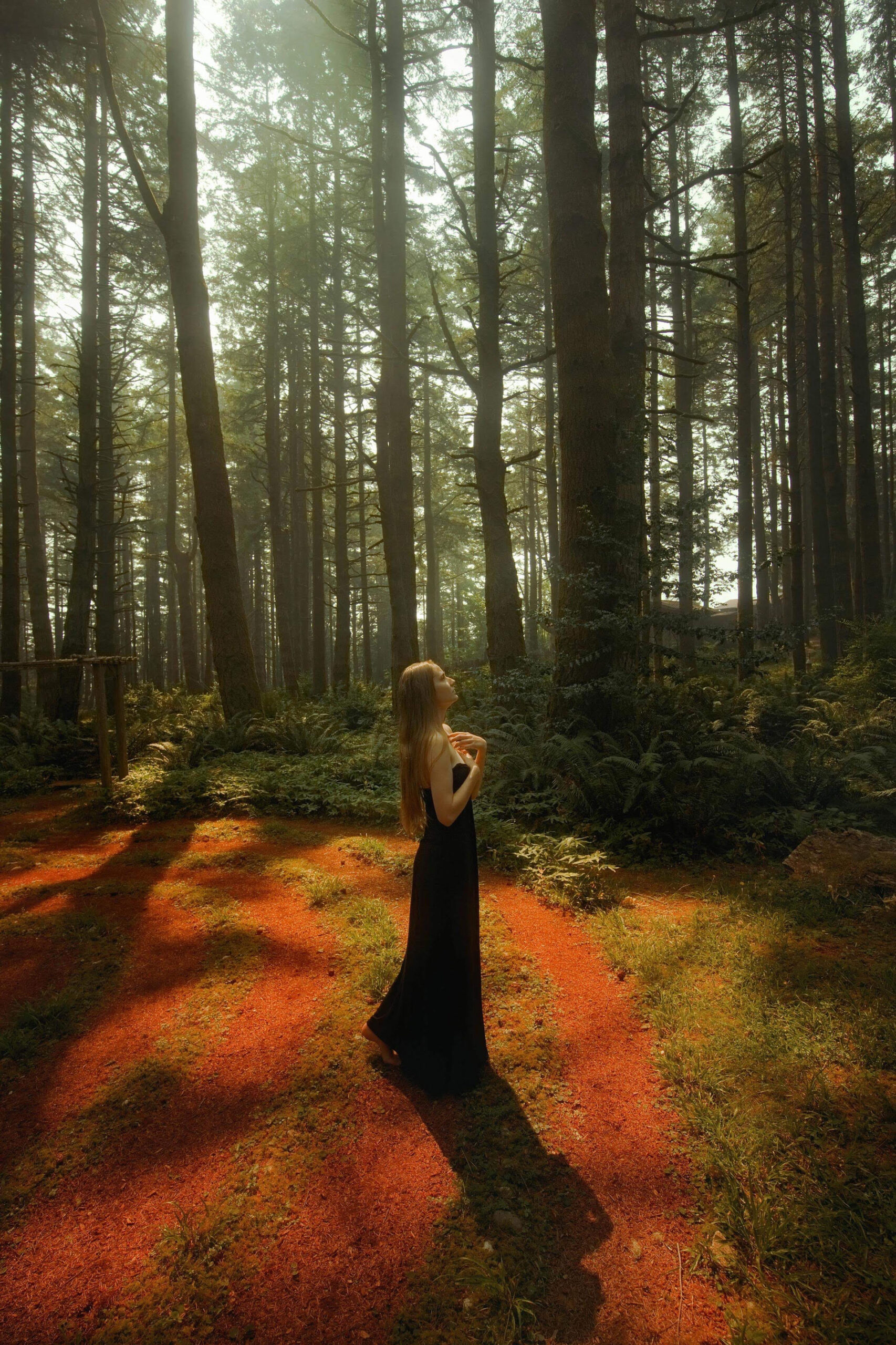
Stop 3: Observe Art On The Beach, A Rock With A Face, And A Historic Lighthouse In Bandon
With its gorgeous beaches and picturesque sea stacks, Bandon is one of our favorite stops on this Oregon coast road trip. The small coastal town has a proud history of cranberry growing, a fascinating, creative arts scene, popular breweries in Old Town, a historic lighthouse, and phenomenal golfing opportunities at the Bandon Dunes Golf Resort. And of course there’s plenty of fresh, delicious seafood to be consumed.
Best Things To See and Do In Bandon
The Coquille River Lighthouse, located in the Bullards Beach State Park just two miles north of Bandon, turned off its light in 1939, but was an integral part of leading boats safely across the bar at the Coquille river entrance. The lighthouse is open to visitors from mid-May through September and is staffed with people knowledgeable in the lighthouse’s history.
When you’re done exploring the lighthouse take a walk down to the beach and enjoy the sand and scenery! The park also has a wonderful campground that is open year round if you’re up for camping.
If you arrive in Bandon at the right time of year, usually the winter, you could be in for some exceptional storm watching opportunities. Bandon is often referred to as the “Storm Watching Capital Of The World.” Right after a big storm, the waves are particularly high and fierce, and seeing them crash against the shore and rocks is a sight to behold.
The sky will have also had a chance to clear a little to allow you optimal viewing. You might even be lucky enough to find a hand blown Japanese glass fishing float that has been known to make a rare appearance on the Oregon coast shore after a storm.
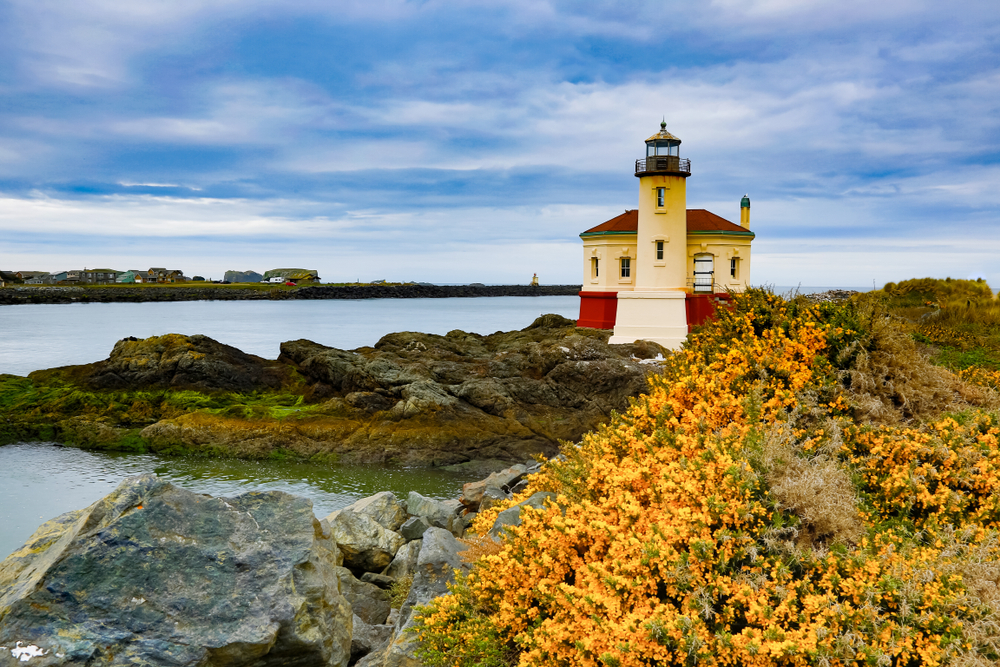
The best spot for storm viewing and great views year round is Face Rock Viewpoint. There is a well-known legend surrounding Face Rock that involves Seatka, the evil spirit in the sea, capturing the Princess Ewauna. And as she refused to look him in the eye and looked to the moon instead, you now see her face in the rock gazing outwards.
This is the perfect spot for seeing Face Rock and the other remarkable sea stacks all of varying sizes and shapes jutting out from the ocean. There’s also a path down to the beach as well as bathrooms and plenty of parking.
Also at the Face Rock Viewpoint beach are the spectacular “Circles In The Sand” labyrinths that are always a big draw for locals and tourists alike. These spectacular sand labyrinths are the creations of Denny Dyke whose original designs were used for his own personal meditation. They’ve now become a remarkable public phenomenon.
His stunning art projects allow people to walk the labyrinths becoming a part of the artwork while allowing them time to just be with their own thoughts. His designs are never planned and are created on the spot. To experience this fascinating art display, keep an eye on the Circles In The Sand website for the current schedule.
Where to stay in Bandon:
Budget: Table Rock Motel. Check rates: Booking.com
Mid-range: Windermere On The Beach. Check rates: Booking.com
Mid-range: Best Western Inn at Face Rock. Check rates: Booking.com
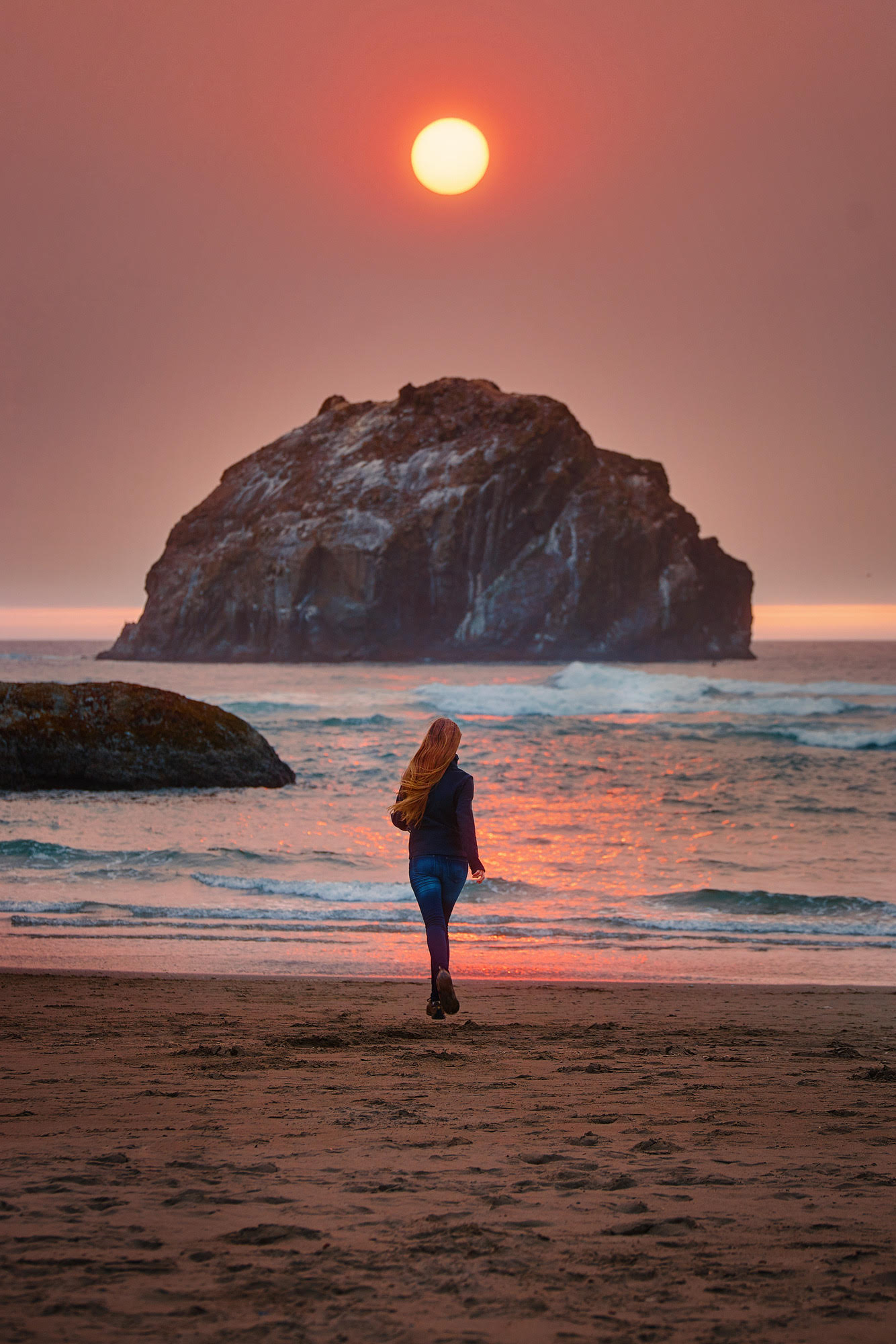
Stop 4: Hike Or Drive Through Oregon Dunes National Recreational Area
One look at the Oregon Dunes National Recreational Area will leave you in awe as you gaze at the majestic rolling hills of sand. Covering over 40 miles of Oregon coastline and 32,000 acres total, its natural beauty is just the beginning. It offers easy beach access, excellent recreational opportunities, hikes and plenty of camping options.
The combination of dunes, ocean, and forest in such close proximity to each other is remarkably unique. On top of that, the dunes are constantly shifting and changing creating new landscapes every day.
It almost feels like the sandy hills are alive. No matter how many times you visit the Oregon Dunes National Recreational Area, you’ll experience something new every time.
We suggest beginning your time in the recreational area by exploring the dunes on foot. There are a number of spectacular, worthwhile trails, but if you head to the Oregon Dunes Day Use Area you’ll find two great hiking options that will take you through the dunes to the beach and back. The shorter option will take you straight to the beach and back for a 2 mile round trip hike.
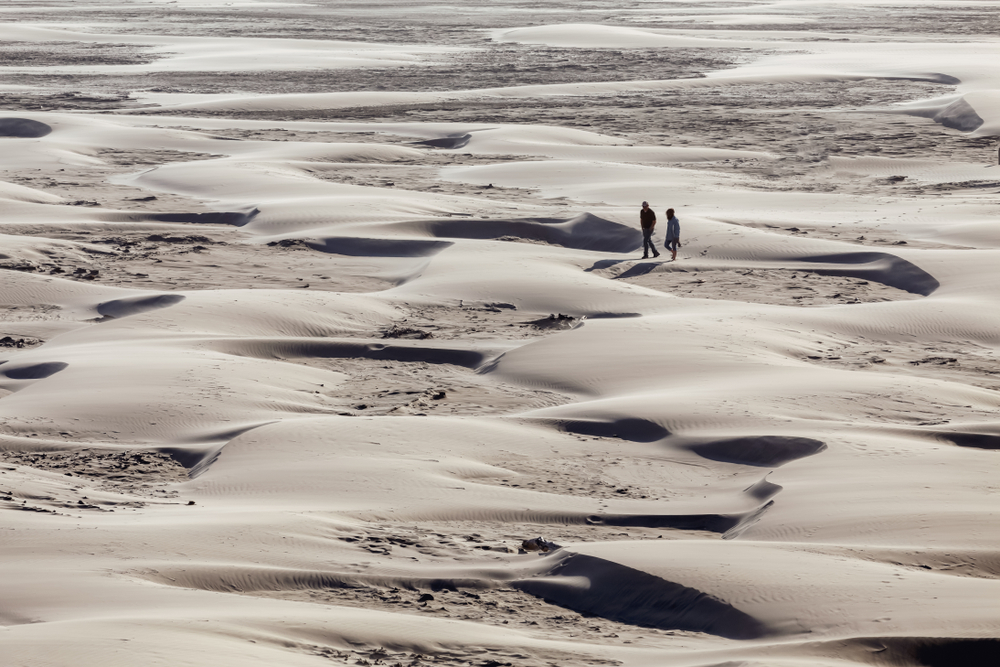
If you have more time and would like to spend more time walking along the beach, we suggest doing the entire Oregon Dunes Loop Trail for just over 4.5 miles. Hiking is a great way to experience the dunes in more peace and quiet.
Just remember the sand is thick and far more tiring than your average hiking trail surface. The hike is certainly worth the effort though.
If you’re looking for a less physically taxing way to explore the dunes, you’ll want to hop in a four-wheel drive, ATV or dirt bike and go dune bashing. Three specific areas, or about half of the Oregon Dunes National Recreational Area is open to Off Highway Vehicles (OHV) for both open and trail driving. If you don’t have your own OHV, there are a number of companies in the area that offer rentals and tours such as Spinreel Dune Buggy & ATV.
Take a look at their website for more detailed info on pricing and availability. If you have your own four-wheel drive and are looking to rough it overnight among the dunes there are camping sites available. These sites are only accessible by four-wheel drive and must be booked in advance during the peak season (May 1-September 30).
Where to stay near the Oregon Dunes National Recreational Area:
Mid-range: Best Western Salbasgeon Inn & Suites. Check rates: Booking.com
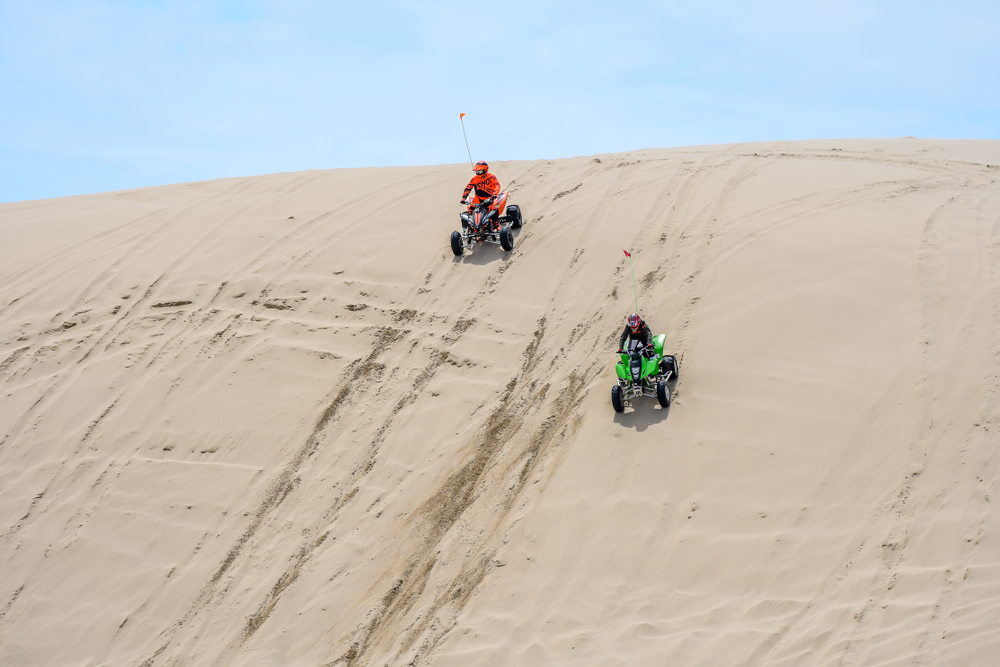
Stop 5: Enjoy The Quaint Coastal Town Of Florence And Its Historic Lighthouse
As you continue driving the Oregon coast you’ll find yourself in the quaint town of Florence, located at the mouth of the Siuslaw River. The town is small, but full of activities, and the landscape is dreamy for photographers. The views along the marina are breathtaking and the historic town offers plenty of great dining and shopping opportunities as well as many galleries.
Taking a stroll around the town is a great way to take in all the sights and history. From the Siuslaw Pioneer Museum you’ll also find you can take a self-guided walking tour of the town’s historic buildings and sites.
You might also want to take a moment to enjoy the wonderful views of the historic Siuslaw Bridge at the Siuslaw Bridge Interpretive Center. Everything about this town is cozy and unique. And you’re sure to feel rejuvenated after breathing in the crisp, salty air in this coastal town.
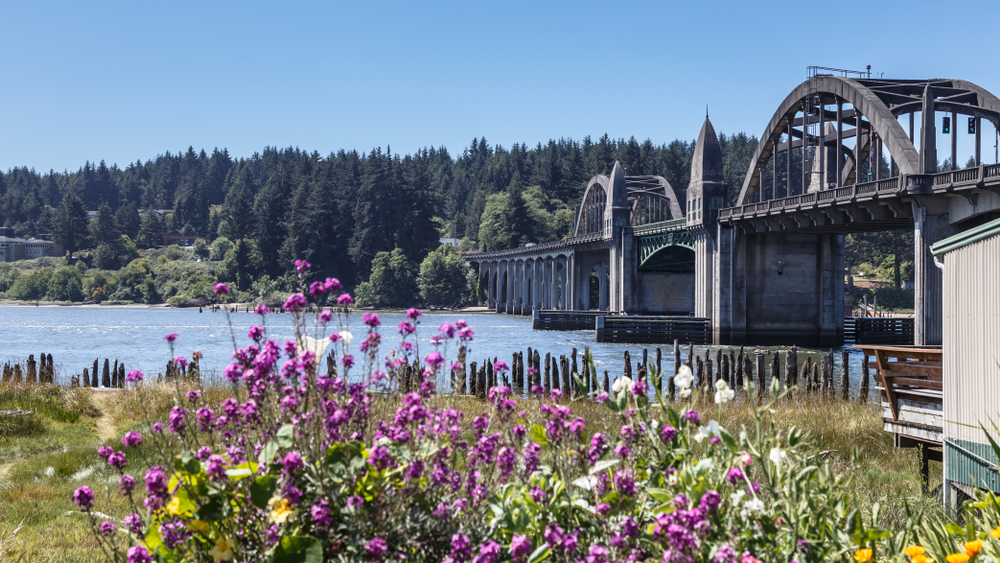
Today the historic Heceta Head Lighthouse towers over the Oregon coast as a State Scenic Viewpoint. The lighthouse can be seen from many miles away as you approach it on Highway 101. The lighthouse was built in 1894 and was named after the explorer Bruno de Heceta who sailed around the Pacific Northwest on behalf of Spain in 1775.
Multiple lighthouse keepers were needed to operate the lighthouse and homes were built for the keepers and their families beside the lighthouse. Later, the Coast Guard would use the lighthouse as a lookout point during WWII.
The lighthouse is operating today, and what once was the assistant keeper’s house is now the Heceta Lighthouse Bed & Breakfast, giving you the perfect opportunity to stay overnight at the lighthouse if you wish. If falling asleep to the sound of crashing waves is appealing to you, you might want to give it a try. Though be warned there are rumors of a ghost by the name of Rue that frequents the B&B.
When visiting the lighthouse, you can attend a daily program given by lighthouse staff. There are also interpretive panels for your convenience if you visit the lighthouse when it’s unstaffed.
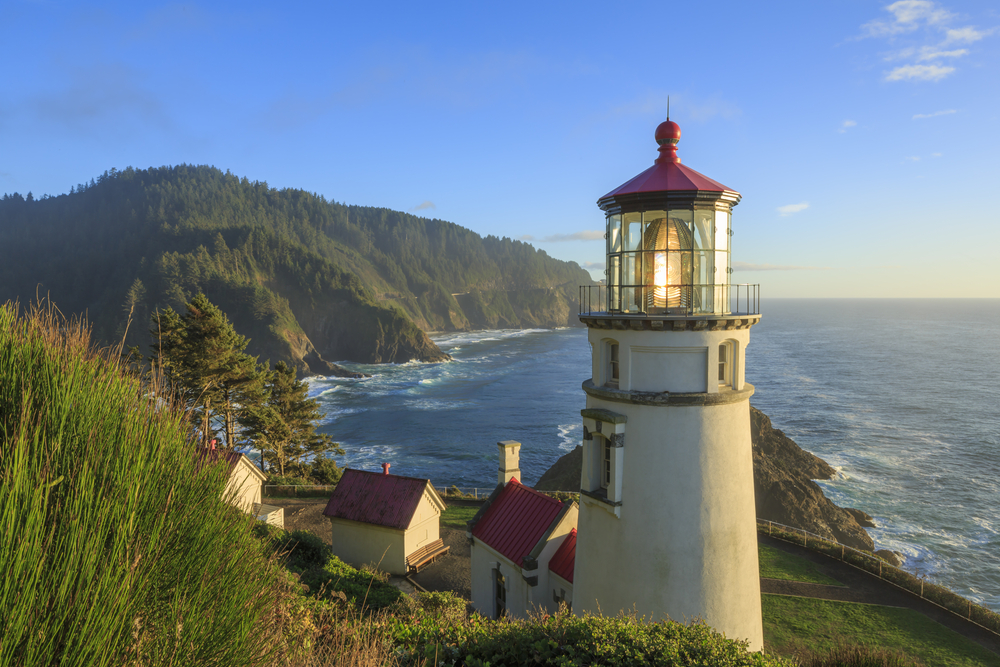
You’ll need to pay a $5 day-use fee to park unless you have an Oregon State Park Pass. There are many trails of differing lengths around the lighthouse, but we suggest at the very least hiking from the parking lot up to the base of the lighthouse.
While here, you might also want to take a short hike along the Hobbit Trail to Hobbit Beach. You’ll find the parking lot for the trail across the highway roughly half a mile from the Heceta Head Lighthouse Viewpoint. As you continue on this mystical, forested trail you’ll want to head right at the sign/junction to get to Hobbit Beach and enjoy some quiet beach moments.
If you choose to access the lighthouse from this trail, you’ll turn left at the junction instead, and this route will take you to the lighthouse. Hiking to both the beach and the lighthouse in one trip is very doable. Just allow yourself 3-4 hours for hiking and enjoying the beach and lighthouse.
The largest sea cave in the United States is impressive, but the highlight of the site is the massive Steller sea lion colony you’ll find inside. The area is also a great place to potentially spot other animal life including gray whales, humpback whales, orca, dolphins, western gulls and Brandt’s cormorants. The winter (and possibly the spring) are the best time to spot the sea lions in their cave, but if you’re hoping for a whale sighting, summer is your best shot.
The Sea Lion Caves is a privately owned wildlife preserve so there’s an entrance fee of $14 for adults, $13 for seniors and $8 for children ages 5-12. Because of the cost, be sure you’re visiting in the winter or spring if seeing the sea lions is important to you.
The natural sea cave is remarkable, but seeing the sea lions considerably enhances the experience. In the summer, the sea lions tend to be on the rocks outside the cave where they do their breeding and birthing.
Parking is free on the side of the highway, just be careful crossing the highway. It can be dangerous with traffic. There’s a nice, though touristy gift shop, popcorn and snacks if you’re interested before heading into the cave.
There are 37 steps and 400 yards of walking to reach the elevator that will take you down to the cave. You can spend as much or as little time as you want in the cave.
If the Oregon Dunes National Recreational Area left you hungry for more adventures among the dunes, you’re in luck because Florence just so happens to be home to Sand Master Park. Though it helps, you don’t have to have snowboard or surfboard experience to have a thrilling time sand boarding on the dunes.
Go to the Sand Master Park website for information on board rentals as well as sand board lessons for those who feel they need some instruction before being let loose on the dunes themselves. The park is great for both adults and families with children. Be prepared to get sand absolutely everywhere and to have an experience that is just pure fun.
Where to stay in/near Florence:
Mid-range: Old Town Inn. Check rates: Booking.com
Mid-range/Luxury: Driftwood Shores Resort. Check rates: Booking.com
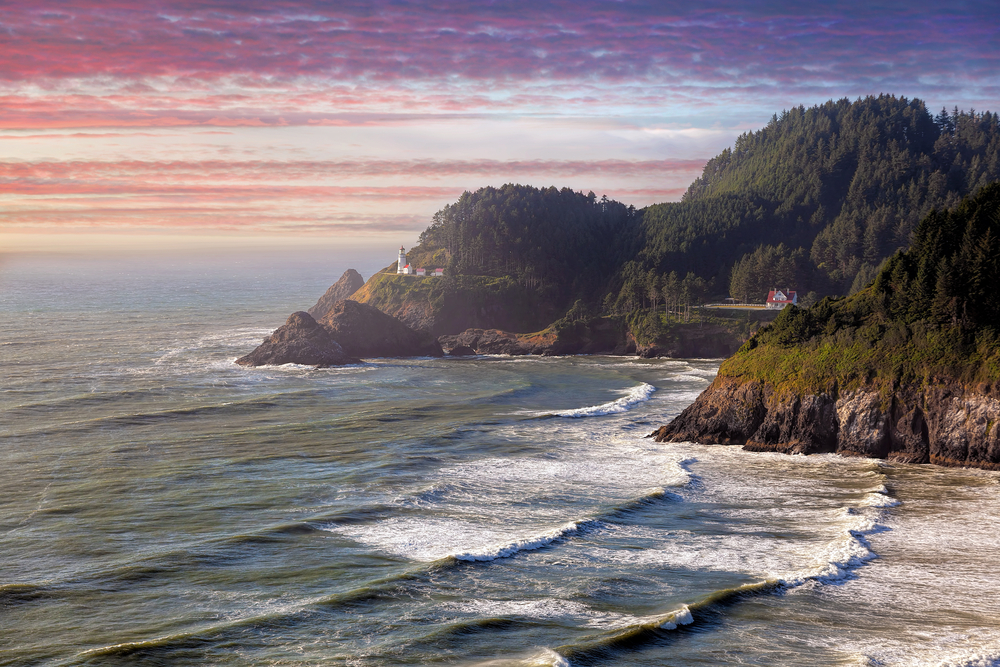
Stop 6: Marvel At Nature’s Unique Creation At Devil’s Punchbowl State Natural Area
Though the Devil’s Punchbowl State Natural Area is full of hiking trails, tide pools and beaches, the highlight of the area is of course Devil’s Punchbowl itself. It is an entirely different and unusual look at the power and force of the ocean you’ve been viewing throughout this Oregon coast road trip. This remarkable formation was once two sea caves.
When the ceilings collapsed they created the natural bowl shape with the turbulent ocean water crashing within against its center. The punchbowl itself is a quick stop but is impressive and well worth your time.
If you’re lucky you could also potentially spot gray whales from the viewpoint particularly during the short time spans of late December to early January and mid-March to early April. At low tide it is possible to hike down to the base of the punchbowl and view it from the inside, but you have to be particularly careful, because if you get caught down there it could be deadly.
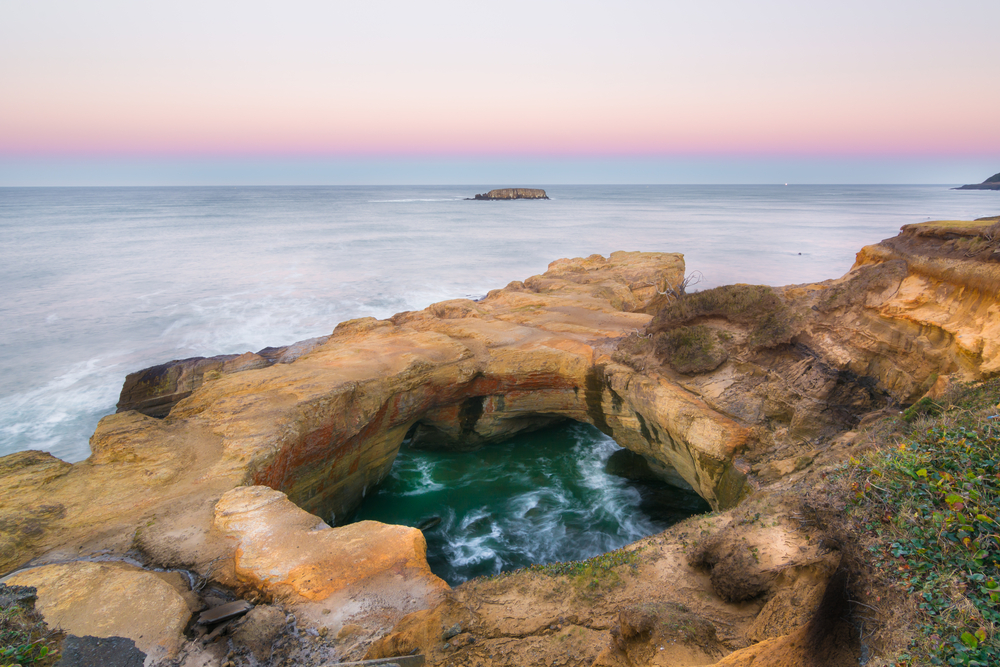
As you head up the coast to Devil’s Punchbowl State Natural Area, we also suggest you stop at Thor’s Well (about 50 minutes south) and the Oregon Coast Aquarium (about 20 minutes south). Thor’s Well is a sinkhole in the rock that seems to suck the ocean water into its depths.
Water continues to endlessly drain into it. It is an often photographed spot but is not always the easiest to find. Once you pass Cape Perpetua going north on Highway 101, start looking out for Thor’s Well.
Thor’s Well is a GPS location you can type in, but here is how to get there just in case: Thor’s Well – Cape Perpetua HWY 101 Yachats, Oregon 97439 USA. Once you arrive where the GPS drops you off, you are on the “water” side of HWY 101 in a small parking lot. To your right, there is a path that leads down a few switchbacks to the rocky coast.
When looking out to sea, imagine there is a clock face. Thor’s Well will be located at about 1:00. Thor’s Well is spectacular but dangerous.
Respect the power of the water and keep your distance from the well. Getting the perfect photograph is never worth risking your life.
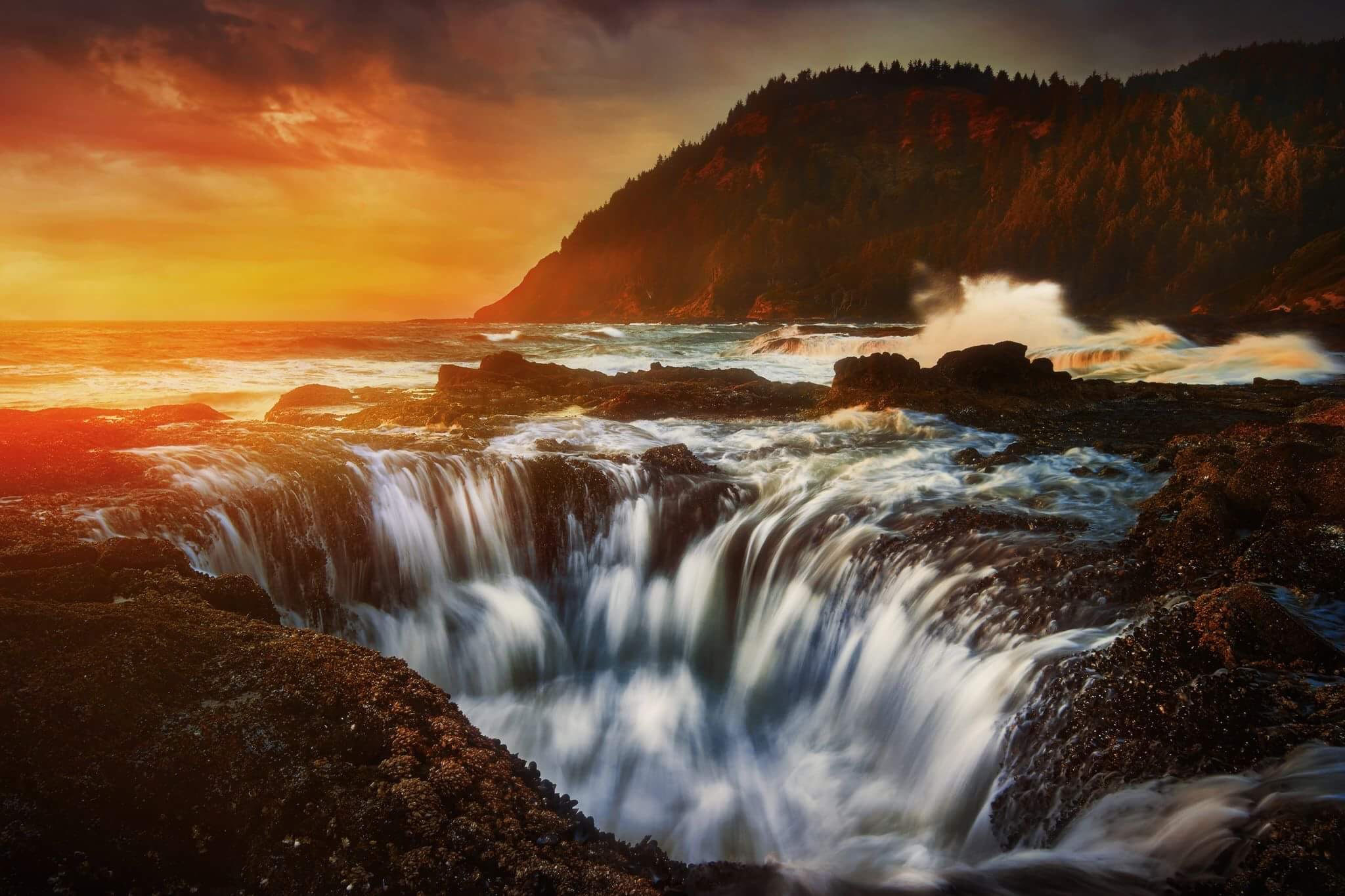
The other stop we recommend is the very popular Oregon Coast Aquarium. There are plenty of fascinating exhibits at this aquarium that include sea otters, sea lions, jellyfish and a tube where fish surround you as you walk through. The aquarium is a great activity for both adults and children.
You’ll find the volunteers are helpful and knowledgeable. Take a look at the website ahead of time for opening hours as they change between winter and summer, as well as the feeding times because watching the animal feedings is particularly exciting. Tickets are $24.95 for adults, $19.95 for seniors and 13-17 year olds, and $14.95 for children between the ages of 3-12.
Where to stay near Devil’s Punchbowl State Natural Area:
Mid-range: Agate Beach Motel. Check rates: Booking.com
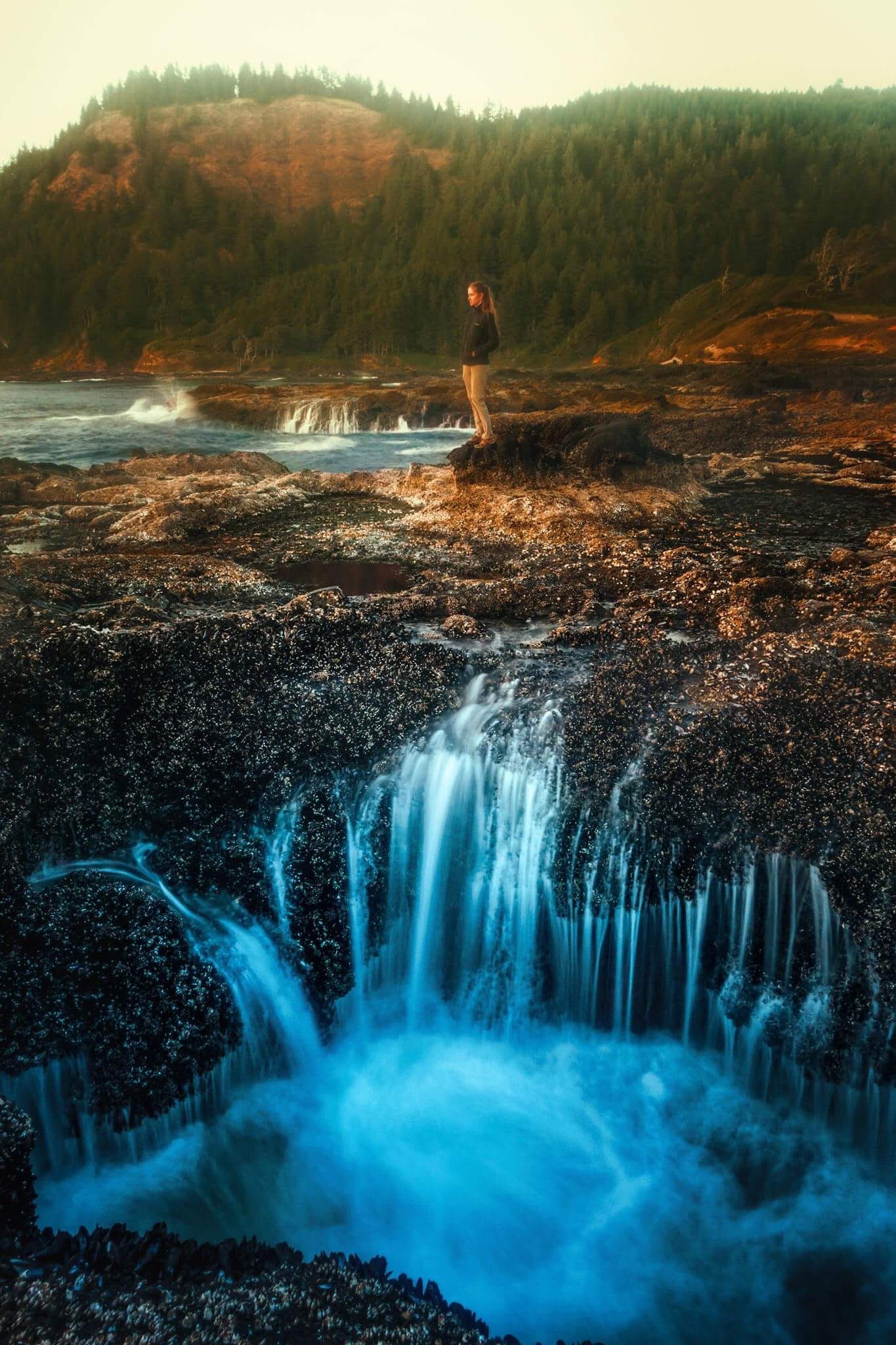
Stop 7: Feel The Sand In Your Toes At The Cape Kiwanda State Natural Area
Cape Kiwanda State Natural Area is known for its sand dune and sandstone cliffs. It is the smallest of the capes on the Three Capes Scenic Route, but is unique and beautiful. Hiking to the top of the sand dune is no walk in the park, but the workout is well worth the spectacular views from the top of the ocean and sea stacks including the famous Haystack Rock.
You might even spot some spouting whales in the distance. From here you can hike back down or slide or run down the cliff.
Be aware that some of the areas around the cape are fenced off for your safety indicating instability at the edge of the cliffs or particularly high waves. Pay attention to these signs as not doing so has proved fatal in the past.
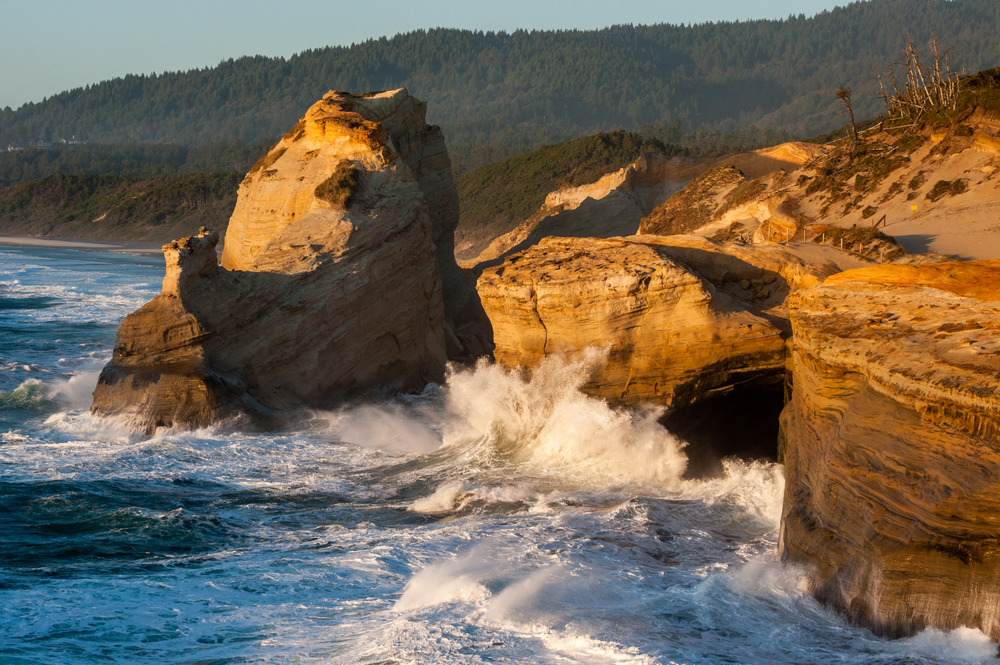
One of the unique aspects of Cape Kiwanda is that you’re allowed to drive up onto the beach in a four-wheel drive vehicle. However, be courteous of the other people enjoying the beach and use common sense so you don’t get stuck. You can also park in the regular parking lot if you’d prefer.
From there, take off your shoes, and explore this sandy paradise. There are great tide pools and sea caves that are fun to explore. There is no fee to visit Cape Kiwanda, pets are welcome and there’s plenty to keep visitors of all ages entertained.
Where To Stay Near Cape Kiwanda State Natural Area:
Mid-range: Inn at Cape Kiwanda. Check rates: Booking.com
Luxury: Headlands Coastal Lodge & Spa. Check rates: Booking.com
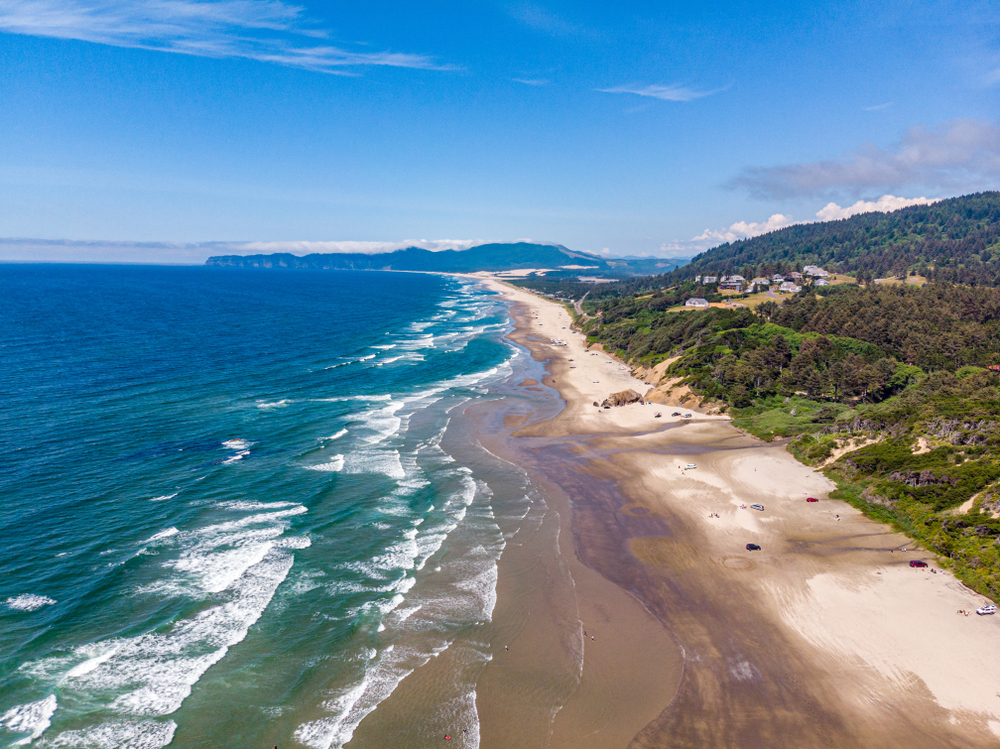
Stop 8: Explore Sea Caves At Low Tide At Hug Point State Park
Hug Point State Park is an absolute treasure that we stumbled upon in our travels. The charm of Hug Point includes a beautiful beach, streaming waterfall, intriguing sea caves carved out over time by the water and tide pools where you might just find starfish and other sea life. There are also picnic tables, restrooms, and plenty of parking spaces.
Hug Point is located just 5 miles south of Cannon Beach. Before the highway was built, travelers would travel by stagecoach to Hug Point where they would hug the sandstone to avoid the tides.
That’s how Hug Point got its name! At low tide you can still see the old path paved by the coaches.
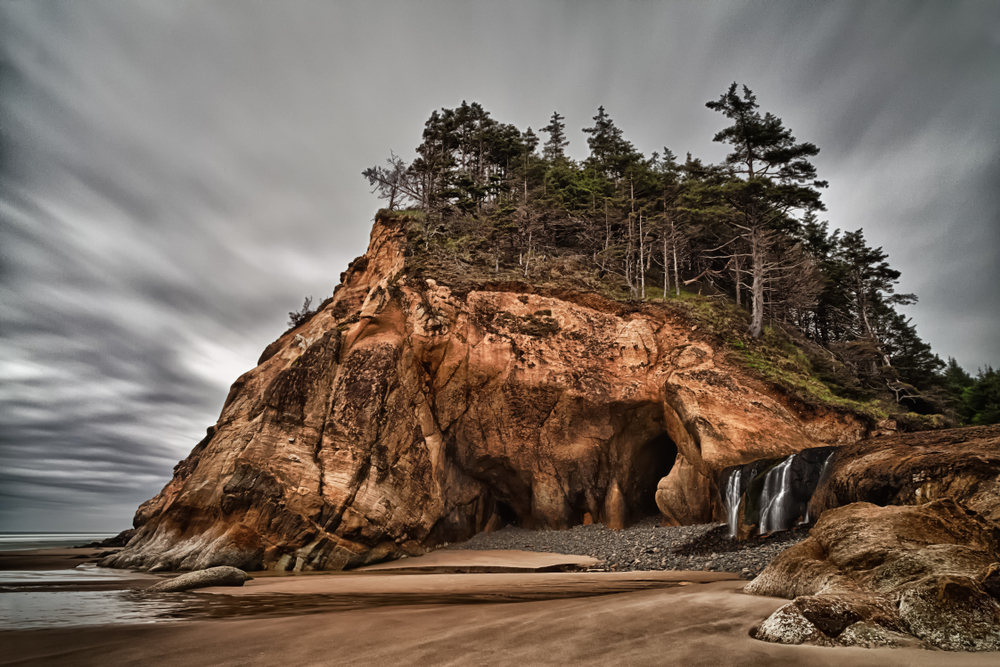
If you’re going to do much in the way of exploring in and around the caves, it’s important that you visit during low tide. Continue to pay attention to the tides so you don’t get stranded. From the parking lot we suggest walking down to the beach.
It’s an easy, roughly half mile stroll. The beach is great for family picnics, and typical beach fun. Be on the lookout for the famous Haystack Rock.
If you’re planning on Hug Point being a shorter stop, you’ll want to head to the north where you’ll find both the caves and waterfall. Be aware that it’s a seasonal waterfall so it may not be flowing or in full force when you visit. The flow will likely be heaviest late in the year.
Where to stay near Hug Point State Park:
Mid-range: Tolovana Inn. Check rates: Booking.com
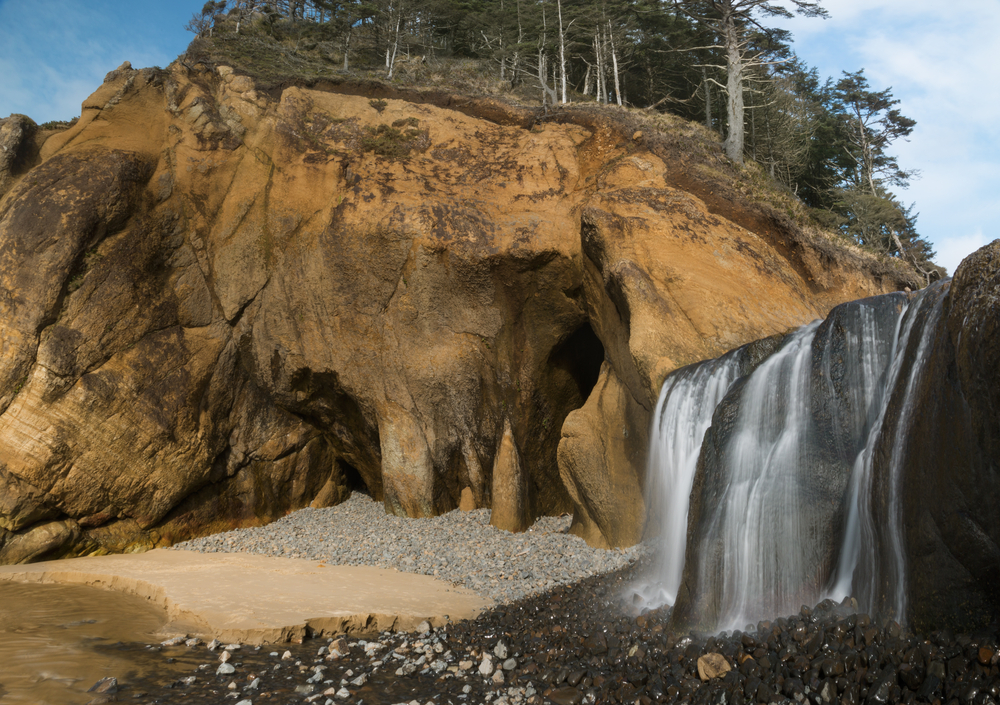
Stop 9: Photograph The Famous Haystack Rock From Cannon Beach
Sandwiched between Hug Point and Ecola State Park is the famous Cannon Beach named after the USS Shark cannon that washed ashore in 1846. The cannon now resides at the Cannon Beach History Center. The real highlight of the beach is the towering, iconic landmark, Haystack Rock.
It’s hard to go wrong with such a beautiful beach and remarkable views. And the small but popular seaside town is quaint and full of art galleries with work by many local artists, great food and shops.
You can’t visit Cannon Beach without admiring Haystack Rock. The 235-foot imposing rock is the third largest freestanding monolith in the world and is visible from almost every part of the town.
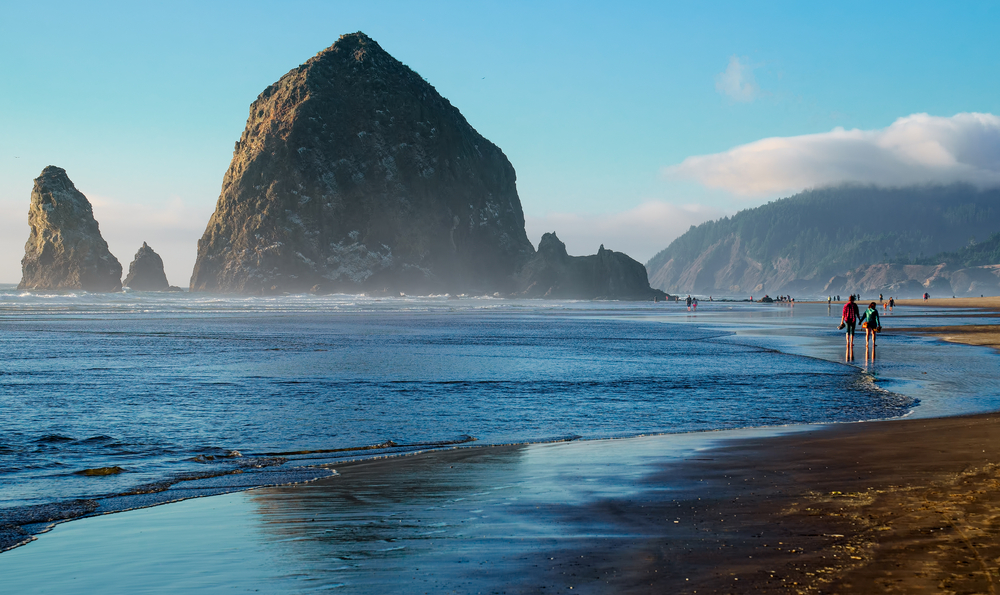
Visiting at low tide will allow you to walk almost all the way up to this enormous rock usually surrounded by ocean water, and view the remarkable ocean life surrounding it such as sea stars, crabs and anemones. You might even spot the colorful, tufted puffins that populate the rock and are easily viewed in June and July.
The beach itself is particularly wonderful to walk at sunset with the brilliant colors framing the silhouettes of Haystack Rock and other sea stacks. If you happen to be visiting in early June, you’ll definitely want to take part in the huge Sandcastle Day event either as a contestant in the sandcastle competition or an observer.
Though Cannon Beach has some really wonderful hotels, they’re quite expensive so we suggest staying outside of the town and driving in. You can still enjoy the town and landscape while saving a little money.
Where to stay near Cannon Beach:
Affordable: Ocean Front Motel. Check rates: Booking.com
Mid-range: Inn at Haystack Rock. Check rates: Booking.com
Mid-range/Luxury: The Ocean Lodge. Check rates: Booking.com
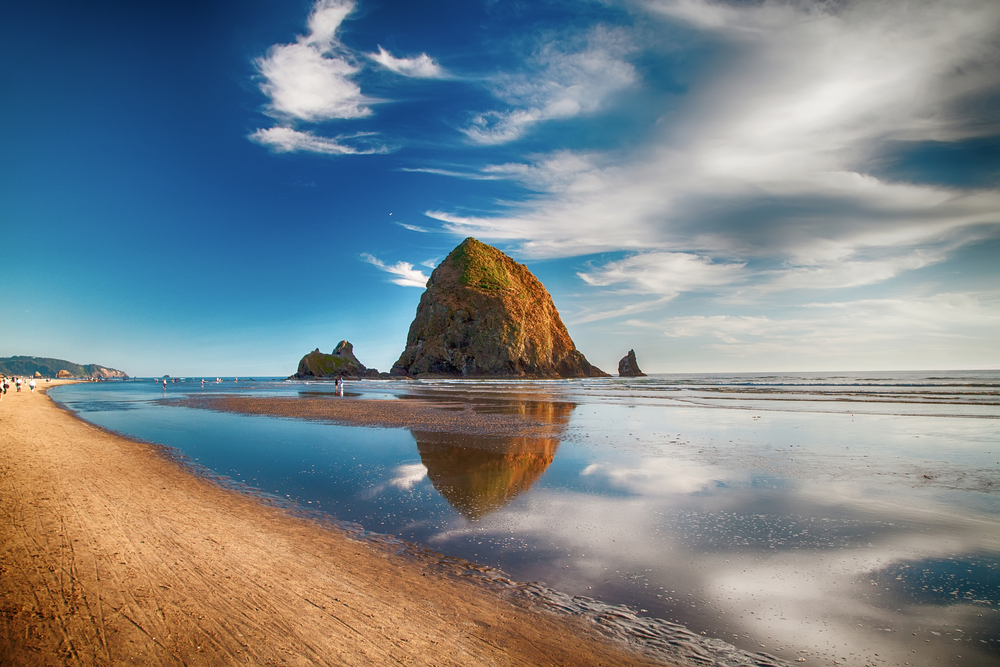
Stop 10: Enjoy The Spectacular Viewpoints and Hiking Trails At Ecola State Park
Ecola State Park is less popular than its Cannon Beach neighbor, but we believe it’s a stop on your Oregon coast road trip that should not be missed. The $5 day-use permit fee is well worth the experiences you’ll have once there. Everything about this land is beautiful, from the Sitka spruce lining the entrance roads to the views out onto the Pacific Ocean.
You have 9 spectacular miles worth of park to explore. The park is the perfect place to bring a picnic, relax on the secluded Indian Beach, and hike the landscape while taking in the wonderful scenery. You might even be lucky enough to spot migrating gray whales in the winter or spring.
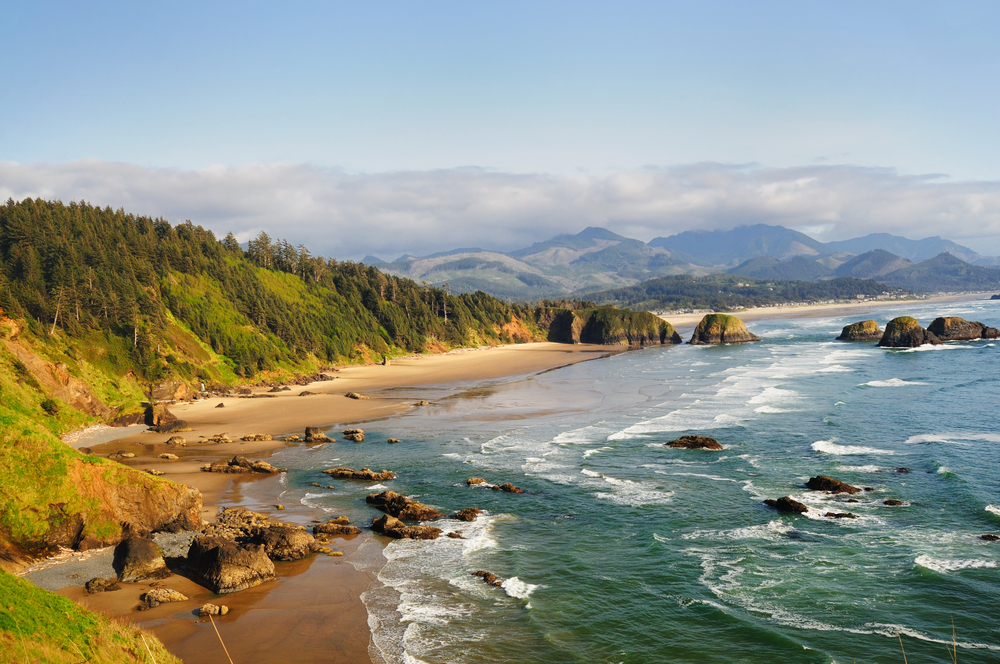
Located close to the entrance is the very popular Ecola Point. This viewpoint offers the most spectacular views of Crescent Beach and further on to Cannon Beach and the Haystack Rock. The sea stacks are particularly imposing and impressive from this vantage point.
With picnic tables and restrooms, this is a great place to start or end your time in Ecola State Park. This is the perfect opportunity to spend a moment taking in the natural beauty of the park while maybe enjoying the picnic you’ve brought along or just taking a load off after a long hike.
One of the most important sights you’ll want to look out for is the Tillamook Rock Lighthouse, “Terrible Tilly.” This notorious, decommissioned lighthouse stands on a basalt sea stack in the ocean. Danger has always been synonymous with the lighthouse.
Due to the location of the lighthouse, the construction alone was dangerous and taxing, and that was only the beginning. Even boating over to the lighthouse was difficult and sometimes took a few tries. The light keepers and the finished lighthouse both had an equally challenging time braving the conditions of the raging sea and thick fog.
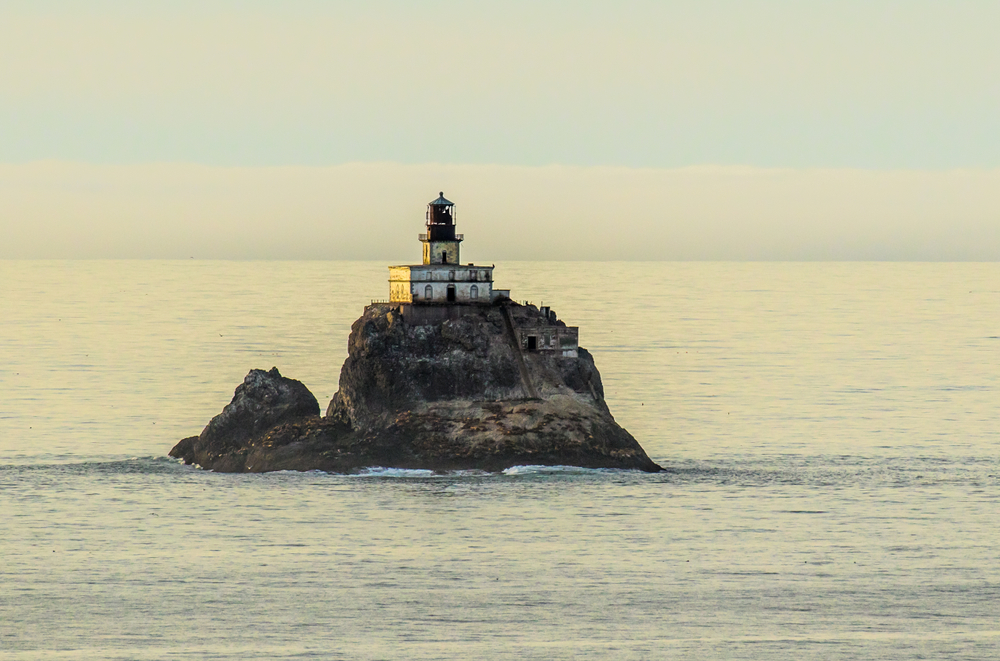
This battered lighthouse turned off its light on September 1, 1957. It is now listed on the National Register of Historic Places. Be sure to get out your camera and capture a photo of this historic lighthouse.
If you’re looking to get your blood pumping, we suggest following partial routes of the famous Lewis and Clark expedition by hiking the Tillamook Head hike, a 10.5 mile round trip hike with spectacular views. You can also choose to have a car ready to pick you up at one end and make this only a one way hike. You’ll start the hike either from the Indian Beach parking lot in the Ecola State Park or from the Tillamook Head Trailhead in Seaside.
Most of the trail takes you through dense forest with the occasional ocean view thrown in. You’ll also be lead to a great viewpoint for looking out at the Tillamook Rock Lighthouse. It rains often in this forest so be prepared to possibly get wet and hike through mud.
Where to stay near Ecola State Park:
Budget/Mid-range: Ocean Front Motel. Check rates: Booking.com
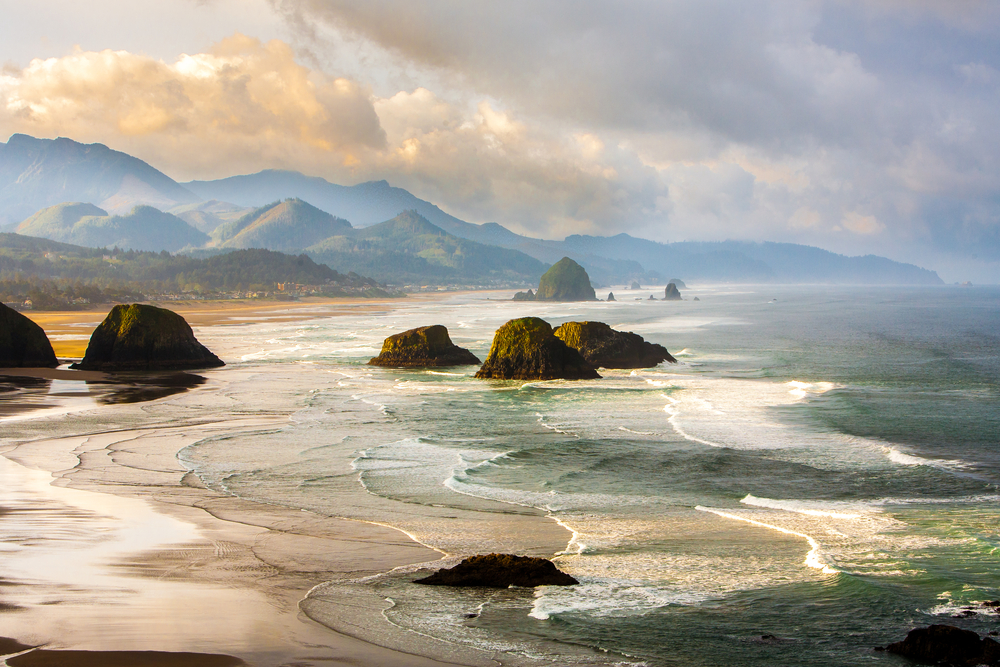
Stop 11: Follow In The Steps Of The Lewis And Clark Expedition In Astoria
Astoria is the Northernmost stop on your Oregon coast road trip itinerary and is roughly a 3-hour drive from Seattle and a 1 hour and 50 minute drive from Portland. Astoria is a port town located where the Columbia River disappears into the Pacific Ocean and is full of history you won’t want to miss. Astoria holds the title of the first European settlement on the Pacific coast.
For those interested in the Lewis and Clark Expedition, you’ll be thrilled to discover that Astoria is home to the Fort Clatsop National Memorial, a replica of Fort Clatsop where Meriwether Lewis and William Clark stayed from December 1805-March 1806 before returning to St. Louis.
Astoria also has a lot of history that revolves around the fishing industry, and was once home to roughly 20 fishing canneries specializing in canning salmon. Some of the historic cannery buildings still stand today. When you arrive in Astoria, you’ll want to head to the famous Astoria Riverwalk.
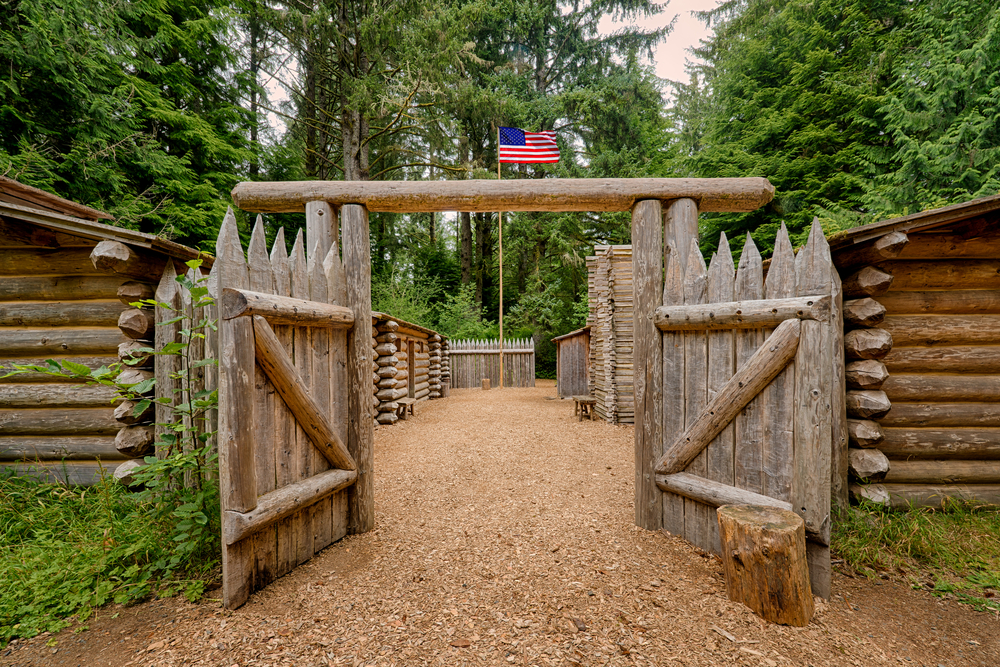
For about a mile you’ll walk taking in all the sights along the water and getting a feel for the town. The downtown is also a great place to walk around with galleries and shops many of which have a Scandinavian influence.
The town is everything you expect when you think of Oregon. It’s grungy and edgy but hip. It’s the perfect blend of past and present.
Beer is a big part of the town today with many of the old canneries being turned into breweries. And of course there’s plenty of natural beauty to be appreciated. After the Riverwalk we suggest heading to the Astoria Column, a 125-foot iconic tower with a spiral staircase to the top that affords a spectacular 360 view over the town and its surroundings including the Columbia River.
If you don’t feel like paying the $5 parking fee when driving to the column or are just looking for a little air in your lungs, the Cathedral Tree Hike might just be perfect for you. This 3 mile round trip hike will take you to the “Cathedral Tree,” a beautiful Sitka spruce that has stood the test of time. A mile later you’ll reach the column.
For a longer hike you might consider the recently constructed Fort to Sea Trail, a 13 mile round trip hike from the historic Fort Clatsop monument to Sunset Beach. Two miles into the hike you’ll reach the Clatsop Ridge overlook where you can see the Pacific Ocean in the distance. Most of the rest of the trail takes you through cow pastures and coastal woodland.
In addition to the domesticated cows, be prepared to potentially encounter wildlife such as elk, deer and eagles. The Kwis Kwis Trail intersects at multiple points with the Fort to Sea Trail allowing you to switch up your hiking path or loop around to create a hike length that’s more suitable to you.
If you’d prefer to only hike one way you’ll have to arrange for a car to pick you up at the other end. You can also start the hike at Sunset Beach where parking is free.
For some family fun in the summer, drive 10 miles south of Astoria to the Young River Falls and Swimming Hole, a 65-foot waterfall and popular swimming hole. You may even see salmon trying to jump the falls. The falls can be tricky to find by GPS but reading the road signs will lead you to the correct place.
Though the falls are often visible from the parking lot you’ll definitely want to walk all the way down to the falls. The walk is not very difficult, but you should still be careful of your footing, as it’s steep with many large tree roots.
The falls are also worth a stop when the weather prevents you from swimming. It’s a great picnic area and hangout spot as well.
Where to stay in Astoria:
Budget/Mid-range: Norblad Hotel. Check rates: Booking.com
Mid-range: Hotel Elliott. Check rates: Booking.com
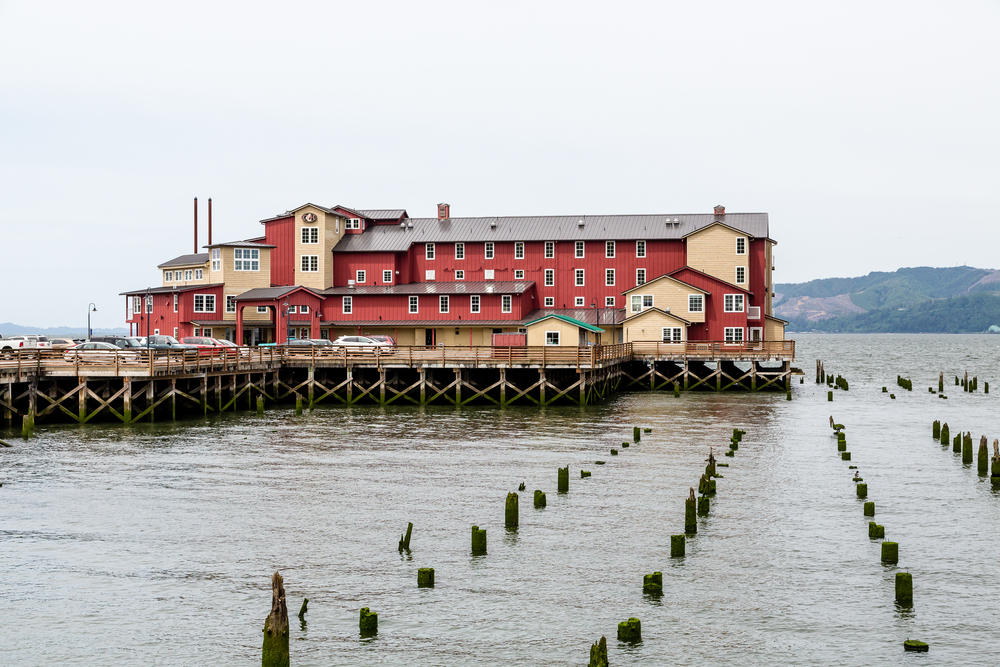
Oregon Coast Road Trip Map:
If you’re more of a visual person, we’ve provided this Oregon coast road trip map below so it’s easier for you to see where each stop is located. For the driving route, check out the link to the map.
Click Here For Oregon Coast Road Trip Map
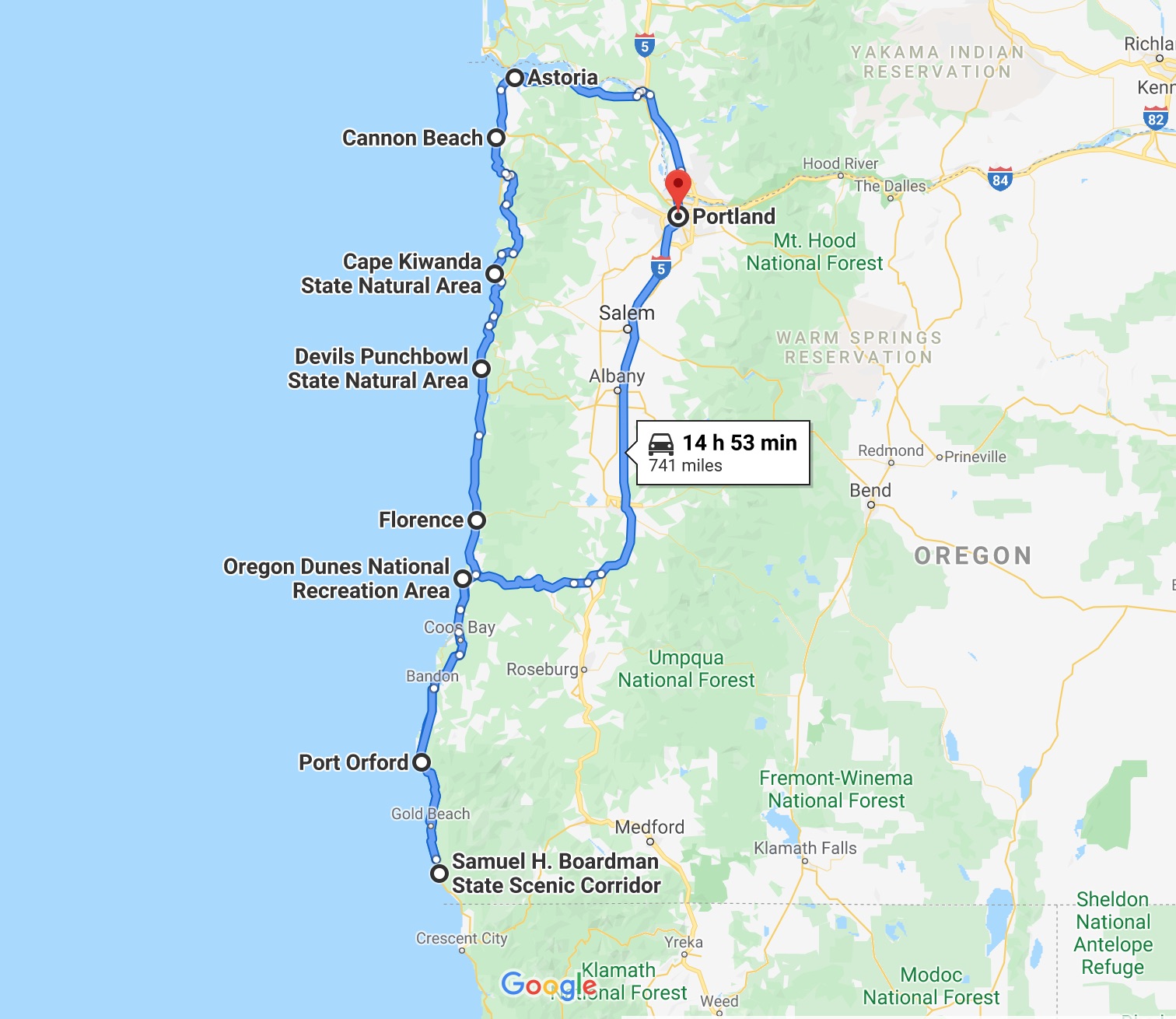
We’re so thrilled you’ve chosen to explore the Oregon coast, as it’s one of our favorite places to visit. There’s nothing quite like the sandstone cliffs, sea stacks, and salty air to make you feel relaxed and free.
The beautiful landscapes and natural beauty will leave you in awe. We hope you enjoy your Oregon coast road trip. Feel free to ask us any questions or tell us about your own Oregon coast experiences in the comments!

 How to Plan a Wildly Romantic Iceland Honeymoon
How to Plan a Wildly Romantic Iceland Honeymoon